Meet CIA’s cutest recruits and follow their 16-week journey as they learn to become CIA explosive detection canines (aka: “bomb dogs”).
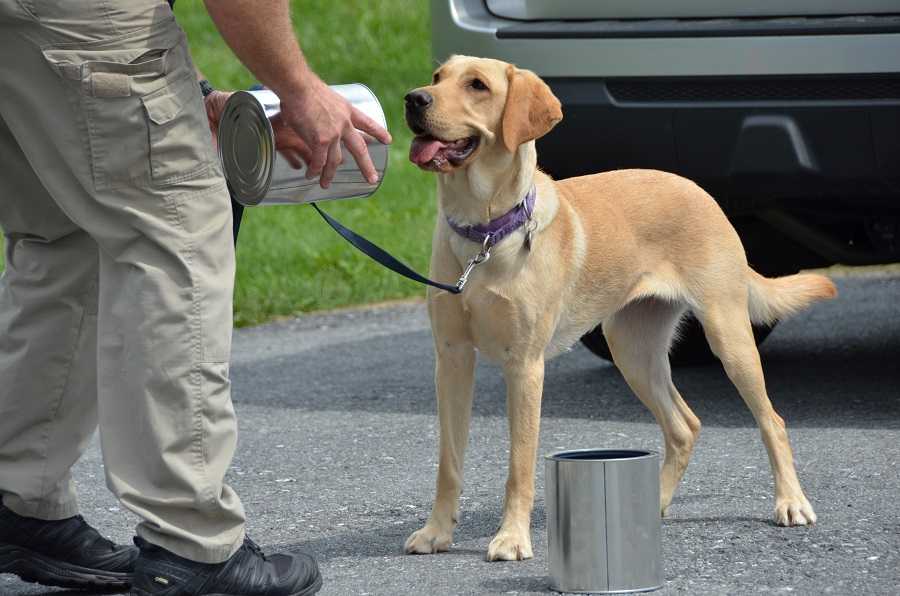
Heide is excited to learn how to become an explosive detection K9 at CIA.
In 2017, we followed a new CIA “puppy class” in real time, taking you behind-the-scenes of our nationally recognized dog training program. (Remember Lulu, the Labrador Retriever that charmed the Nation when she decided she wanted a career change? This was her class!)
We’ve chronicled the pups’ entire journey here in a single story, so you can follow along with Lulu and all of her classmates as they proceed through the 4 month-long program, meet their handlers for the first time and, for most of them, graduate and become certified CIA K9 officers.
When this series was originally released in the fall of 2017, most Americans had no idea that the CIA had its own K9 unit. Our K9 officers and their loyal four-legged partners serve as the first line of defense against explosive threats to Agency personnel and buildings at CIA Headquarters and abroad. Additionally, they are on-call 24/7 to assist local law enforcement and other federal government agencies searching for explosives.
Whether you followed the series in 2017, or are just finding it now, we hope you enjoy it! And be sure to check out our other K9-related stories, including the retirement of one of our most famous pups, Wesley, and some other retired dogs who have gone on to second careers as tail-wagging, comfort-giving CIA Wellbeing K9s in our Agency’s Wellbeing Program.

Freya and her human partner work together to protect the CIA against explosive threats.
Picking the Pups
It’s a bright weekday morning in July as Andy and Steve, the trainers for CIA’s 2017 fall puppy class, exit Interstate 81 onto a two-lane country road in Pennsylvania, rambling past green hills of pastureland and corn, farm houses gleaming in the sunlight, and old barns stubbornly standing against a strong summer breeze.

Heide is ready for her evaluation to join CIA’s puppy class.
They’re headed to Susquehanna Service Dogs in Pennsylvania to evaluate seven Labrador Retrievers as possible candidates for our upcoming puppy class. Officers from Fredrick County Fire Marshal and Fairfax County Police Department in Virginia accompany the trainers, hoping to pick out a puppy for their respective units.
As one of the largest K9 Explosive Detection programs in the Washington Metropolitan Area, and the first United States Police Canine Association (USPCA)-certified “Detector Training Center” in the country, CIA often trains dogs for local law enforcement. We also provide ongoing training, evaluations, and certification for local and federal agencies, including FBI and State Department.
What are CIA Dog Trainers Looking For?
For our fall 2017 "puppy class,” we need to find six dogs in total, four for CIA and one each for Frederick and Fairfax counties. The “puppies” typically range in age anywhere from 8 months to 2 ½ years old and are almost always dogs that are being released from service dog programs.
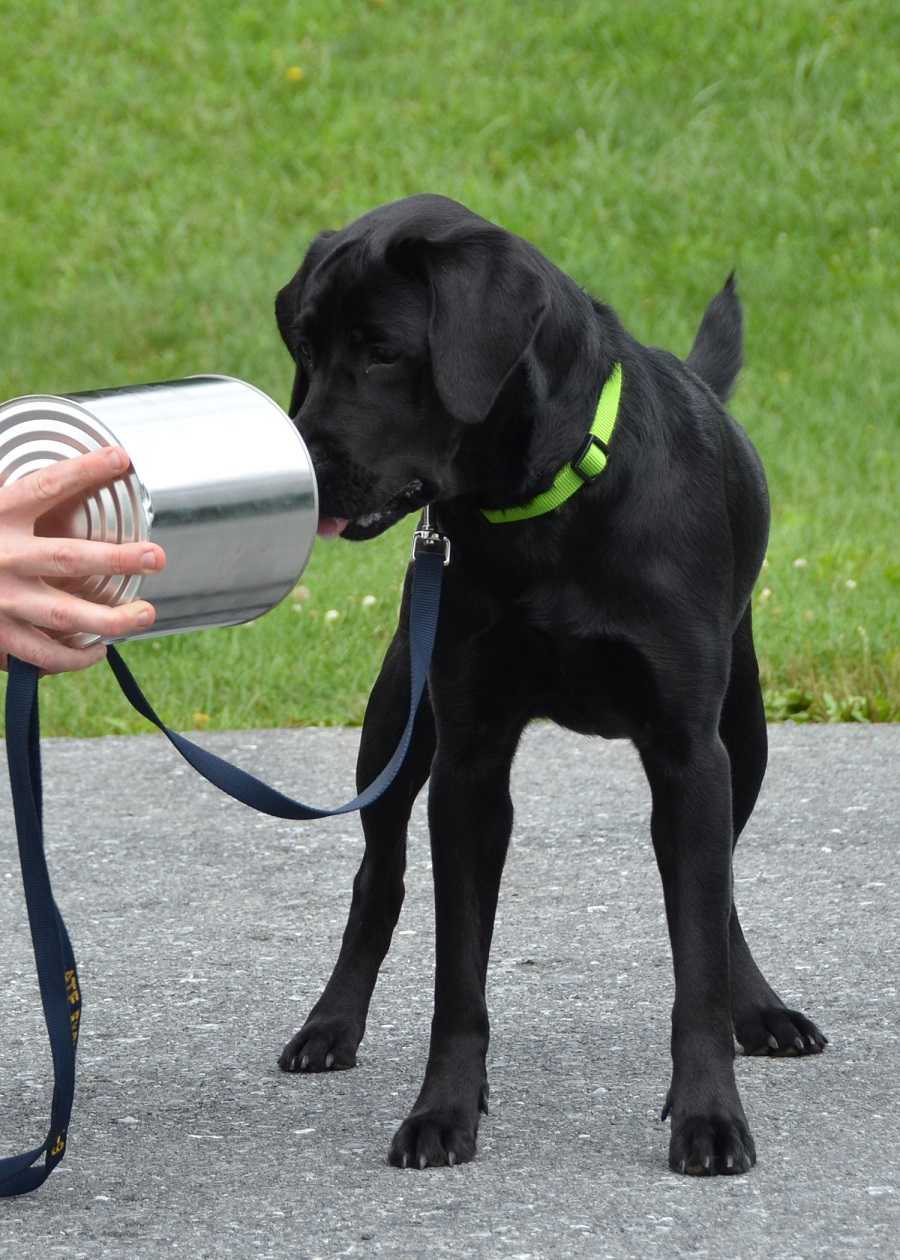
Indigo during evaluations at Susquehanna Service Dogs.
Our instructors visit several different organizations throughout the region—such as Susquehanna Service Dogs and Puppies Behind Bars—to test potential puppies a few weeks before the new class begins. Like many explosive detection programs, we use Labrador Retrievers because of their non-stop energy, friendly demeanor, and love of food. Our program uses positive training methods only, and the dogs are trained using food rewards, so a strong food drive and a high level of energy are extremely important.
Susquehanna, which raises and trains services dogs to assist children and adults with disabilities to become more independent, intimately knows the personalities of each puppy in its program. Many of the dogs are born at Susquehanna, while others enter the program at 8 weeks of age.
Susquehanna’s puppies are raised by volunteer puppy raisers for 16-18 months, and then the dogs enter Susquehanna’s advanced training program for service dog work. Usually, by the time the dogs are between 1 ½ to 2 years old, Susquehanna knows whether or not the dog will make it as a service dog. Not all dogs make the cut.
“If we’re releasing a dog, it’s usually due to health or temperament,” says Pam Foreman, Director of Susquehanna Service Dogs. “The temperament of a good service dog requires a strong work ethic and a certain level of energy, but it has to be a specific kind of energy. They have to really want to work – opening and shutting doors, turning on and off lights, retrieving things, being attentive to their partner and not sidetracked by environmental stimuli including olfactory distractions – but it’s not an over-the-top kind of energy.”
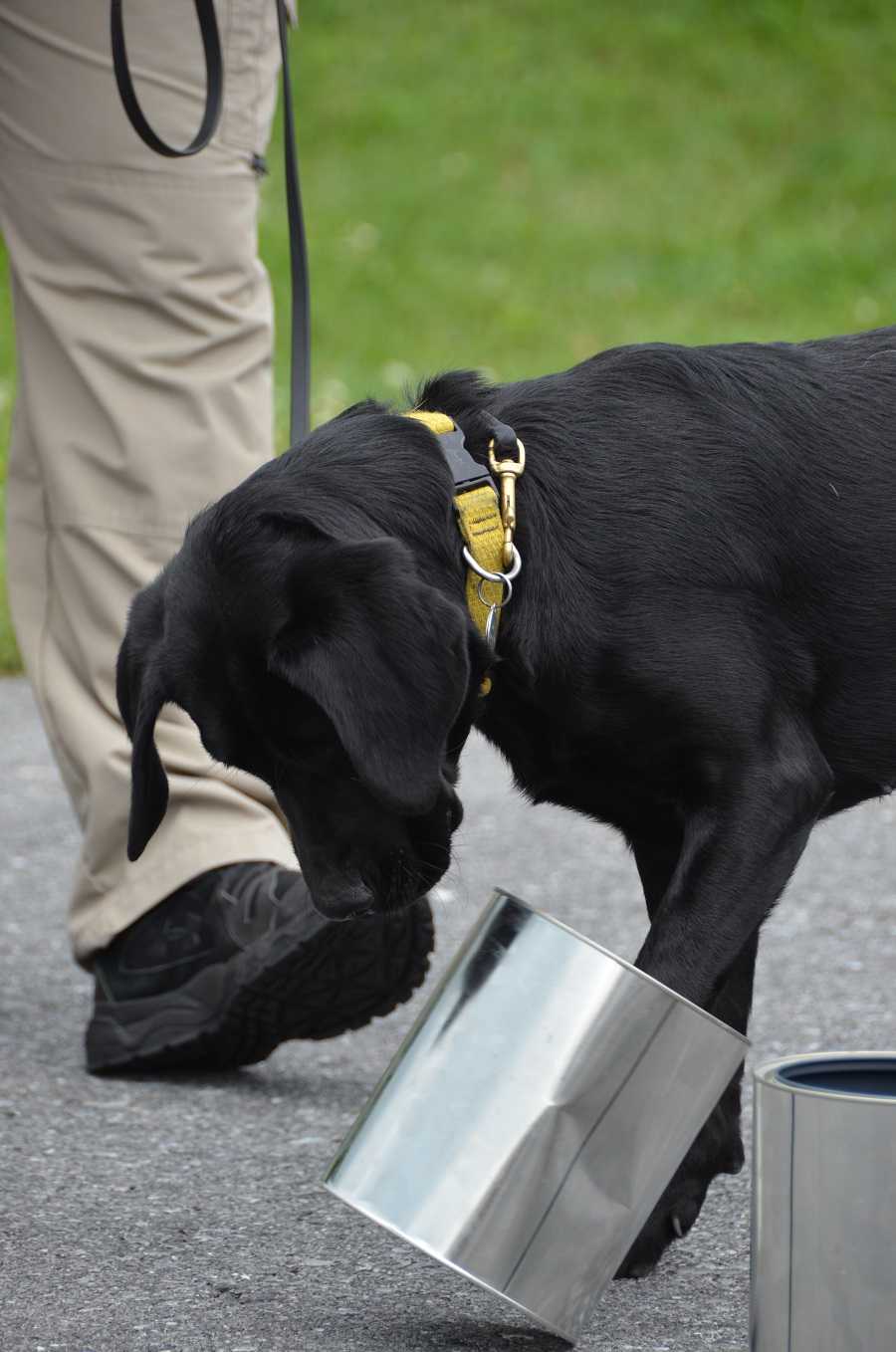
Suni shows her playful, curious side during evaluations.
That over-the-top, impossible to turn off energy is exactly what our CIA trainers, Andy and Steve, are looking for. When a dog gets released from a program like Susquehanna, they now have another place to go.
“In the beginning,” says Foreman, “some of our puppy raisers were a little apprehensive about our relationship with the CIA because they knew there was a certain amount of risk associated with being an explosive detection canine, and also because they wanted the dog they helped train to succeed at being a service dog – that’s why they became a puppy raiser. But now people are proud that their dog, the dog they helped to raise and train, has more options as a working dog and can go on and do great things for our country.”
Evaluations at Susquehanna:
The seven puppies Susquehanna is releasing from the program are six females: Lulu, Freya, Axel, Indigo, Heide, and Suni; and one male, Armstrong.
Andy and Steve, with the help of another CIA K9 instructor, run a series of tests to see how the seven pups react to various situations they might encounter during training or on the job.
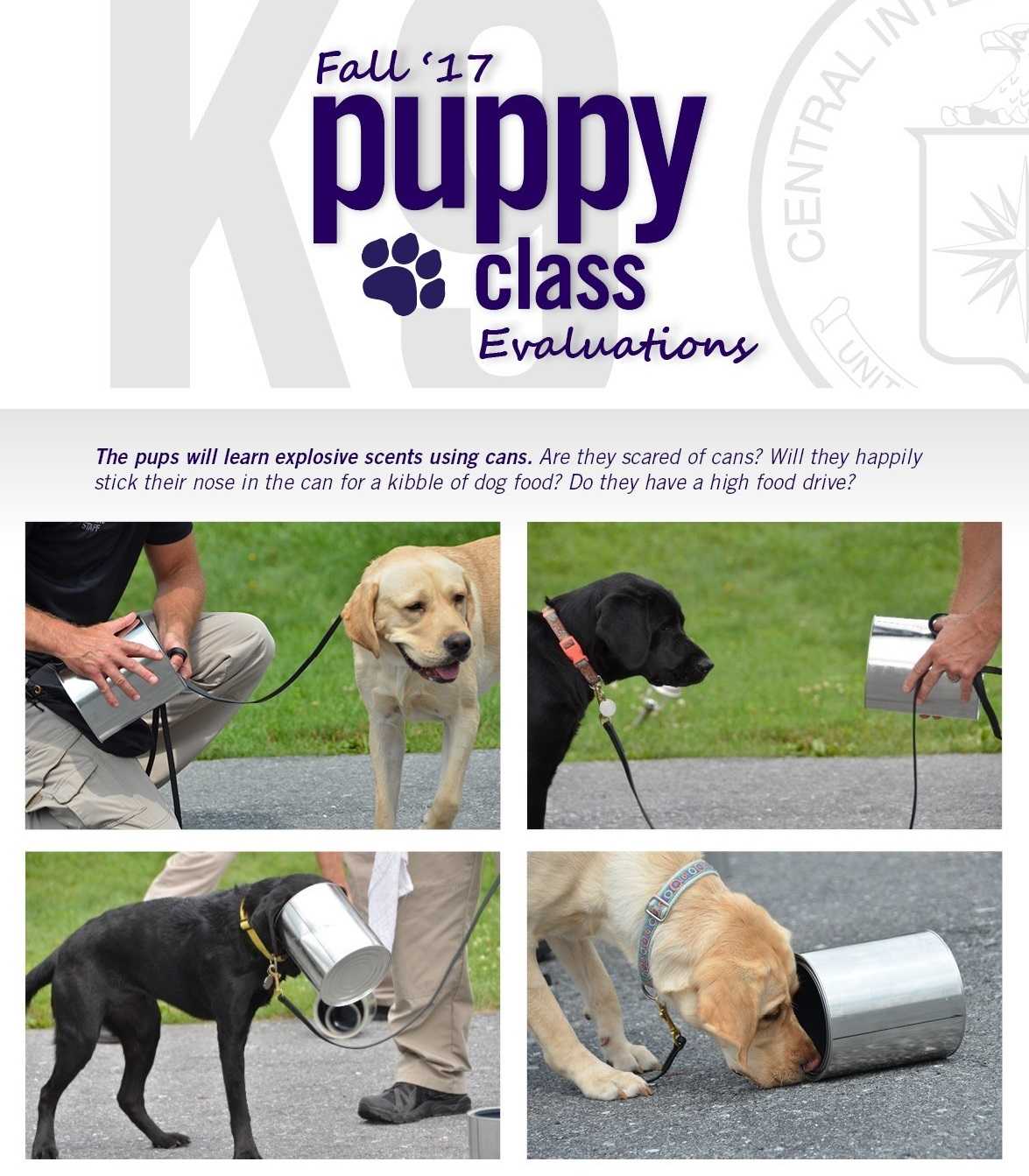
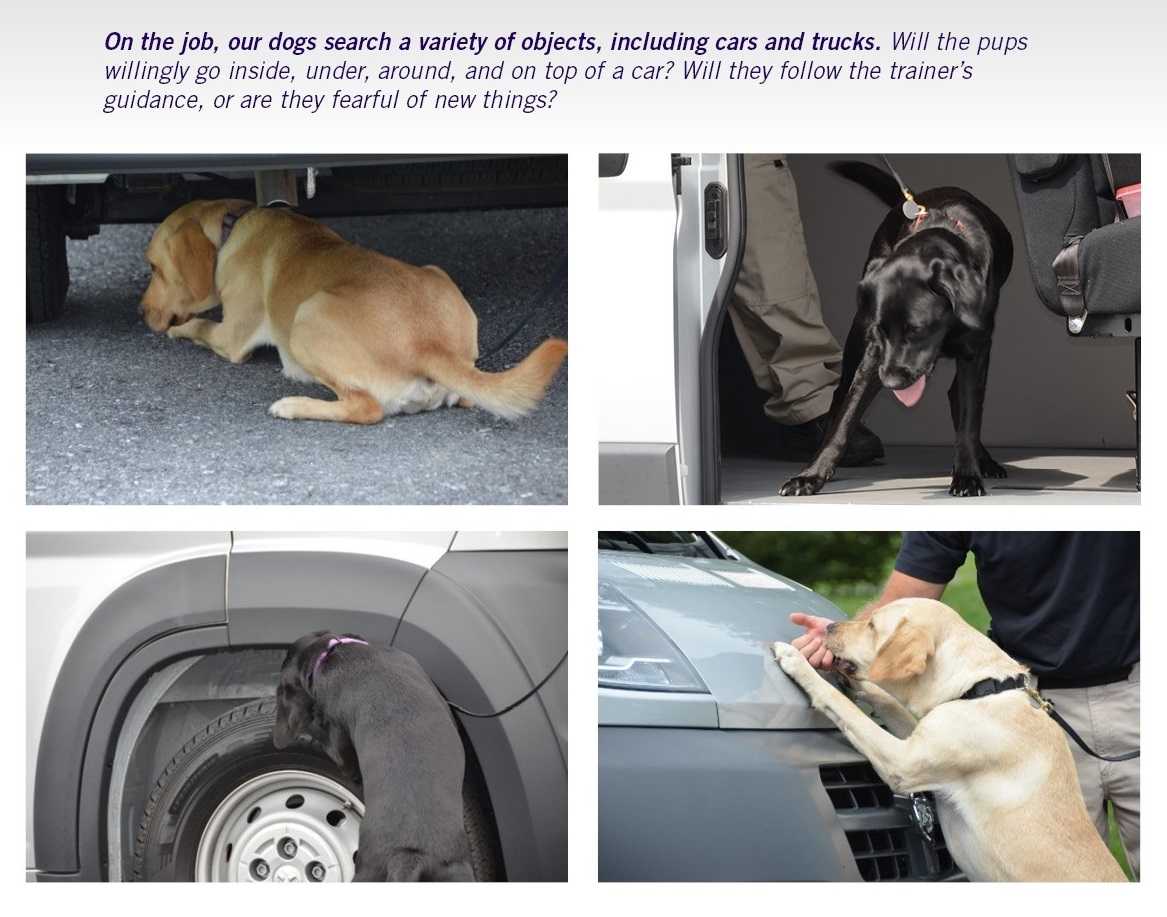
They evaluate and score each dog. Once they’ve visited and evaluated all of the dogs in the different programs under consideration for this fall’s puppy class, the entire CIA training staff will meet to discuss all the dogs they’ve seen over the past few weeks. They’ll chose the dogs with the highest combined scores to join the program.
Which puppies made the cut? You’re about to meet the puppies and find out!
Meet the Puppies!
CIA’s K9 trainers met a lot of really great dogs who would have likely succeeded in our explosive detection program. It was a difficult decision, but there was only room for six.
Meet the CIA’s first all-female Puppy Class!
Meet Indigo!

This feisty 2-year-old black lab is Indigo. She’s surprisingly strong for her small size and has pulled more than one of the trainers off their feet.
Full of energy, Indigo likes to work and loves to eat even more. Indigo is from Susquehanna Service Dogs.
Meet Suni!

Suni is a 2-year-old black lab who is littermates with Heide from Susquehanna Service Dogs’ “astronaut litter.” All the puppies in the litter were named after famous astronauts. Suni is named after NASA astronaut Sunita “Suni” Williams, who holds the record for cumulative spacewalk time by a female astronaut.
Suni is a happy, bubbly, light on her feet pup who is a little too smart for her own good. A problem-solver, Suni is poised to try to outwit the trainers at every turn.
Meet Heide!
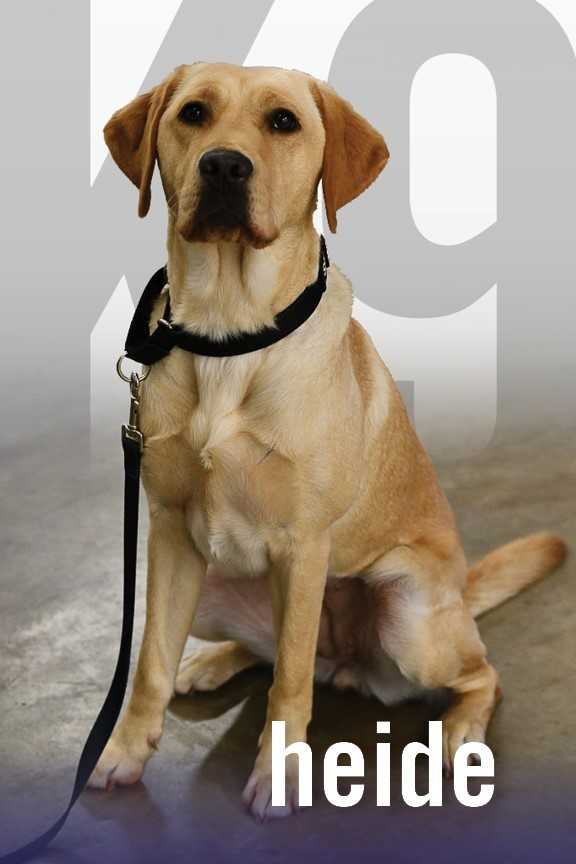
Heide, a sweet 2-year-old yellow lab, is littermates with Suni from Susquehanna Service Dogs’ “astronaut litter.” All the puppies in the litter were named after famous astronauts. Heide is named after NASA astronaut Heidemarie M. Stefanyshyn-Piper, a veteran of two space flights.
Heide loves to jump up on cars, tables, and anything else taller than herself. Playful and silly, she’s calmer than many of the other labs, and when she sees something unfamiliar to her, she’s prone to give a little bark. Heide is being trained for Frederick County Fire Marshal in Virginia.
Meet Freya!
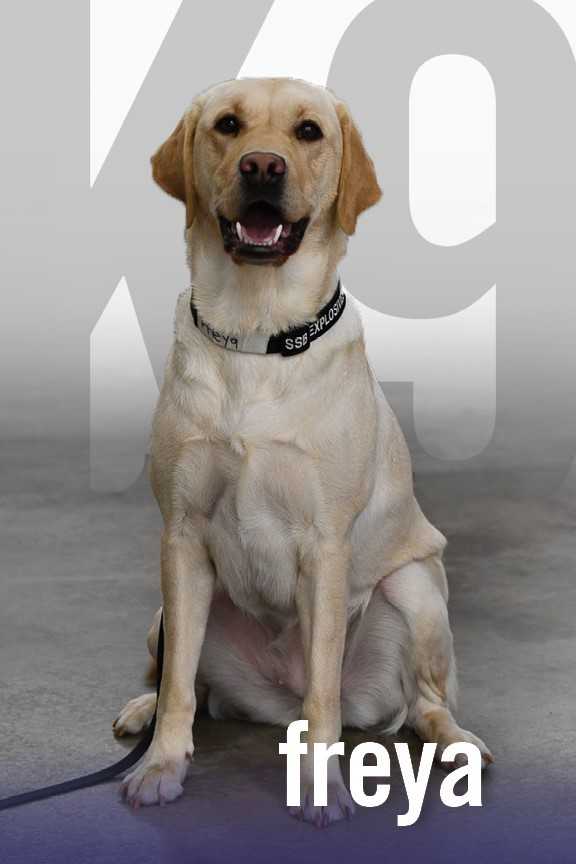
Freya, the oldest in the class, is a yellow lab from Susquehanna Service Dogs. She's a little over 2 years old. Freya is related to another dog in the CIA K9 unit named Nancy.
Freya has an incredible drive and energy, and she stole the hearts of everyone at Susquehanna. Her puppy raiser was actually in law enforcement, so she’s had some familiarity with the life of a police K9.
Meet Lulu!

Lulu, the smallest dog in the class, is a 1½-year-old female black lab from Susquehanna Service Dogs. She’s hyper and silly when she plays, but has an easygoing sweetness and is extremely sensitive to her surroundings and what is being asked of her.
Lulu is being trained for Fairfax County Police Department in Virginia.
Meet Nicole!

Nicole is a 2-year-old, reddish-gold colored female yellow lab from Puppies Behind Bars. She was raised in a women’s prison in New Jersey.
A very friendly, happy dog, Nicole is attentive to what is asked of her, often cocking her head to the side whenever she’s focused on something or someone. She’s a little more sensitive and tentative than the other labs, but like Heide, Nicole loves to show off her athletic ability by jumping into the air on all fours. Focused and independent, Nicole has a ton of personality and charm.
Puppies' First Visit to the Vet
The Agency’s four new K9 recruits – Suni, Indigo, Freya, and Nicole – have their first veterinary exam since joining the CIA program with Dr. Buck Drummond at Old Dominion Animal Health Center. He specializes in the unique medical challenges of working dogs. Heide and Lulu, the other two CIA “Puppy Class” K9s, belong to Frederick County Fire Marshal and Fairfax County Police respectively and will have exams at their local vets.
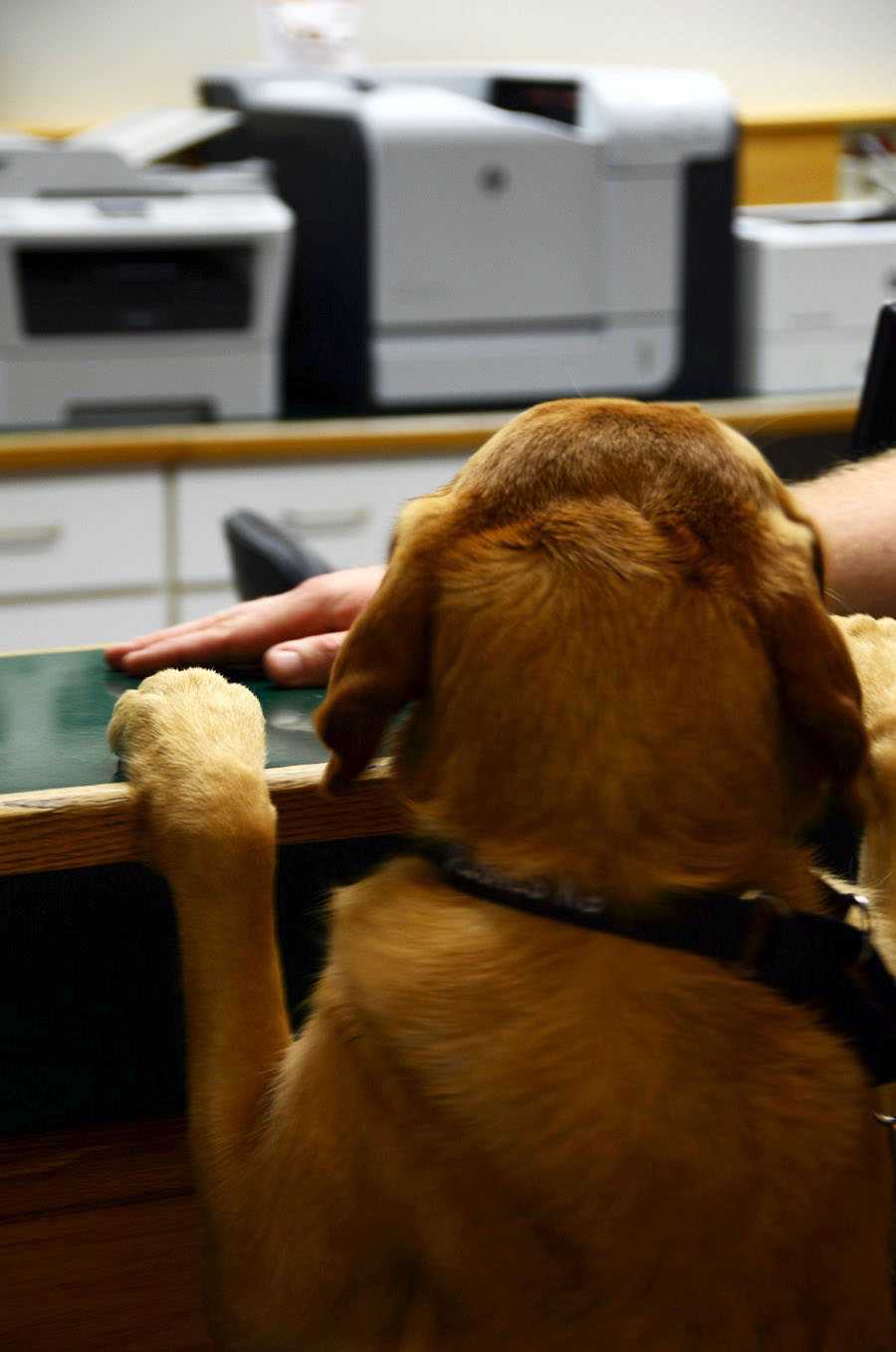
Nicole jumping up on the receptionist counter.
Before classes begin, all Agency dogs go to the vet for a full health exam and any necessary vaccinations. Old Dominion is known regionally for its work with law enforcement and military K9s, including CIA’s K9 officers. They even started a program to help support retired military, CIA, and police K9s called Paws of Honor. Most K9 handlers – whether military, police, or CIA – keep their K9 partners once the dogs retire. Medical care for the dogs, however, is often no longer covered by the government. Programs like Paws of Honor help the handlers with veterinary expenses throughout the retired dog’s life.
First up to see the vet is Suni, a whorl of wiggles and kisses, who leaps out of the CIA K9 van and greets every person, shrub, and butterfly she sees. It’s her nose, however, that most dictates her path. Darting from bushes to shoes to rocks to flowers to trees, Suni follows any curious scent she encounters in the parking lot, weaving a mysterious, seemingly haphazard pattern of puppy energy that only a dog can discern. The same thing happens once she bounds into the lobby of the veterinary clinic, jumping from sniffing rugs, chairs legs and shelves of specialty dog treats, to leaping into the arms of the kneeling veterinarian, Dr. Drummond. A gaggle of puppy kisses greets her new best friend, and then she’s off again tracking another unknown scent.
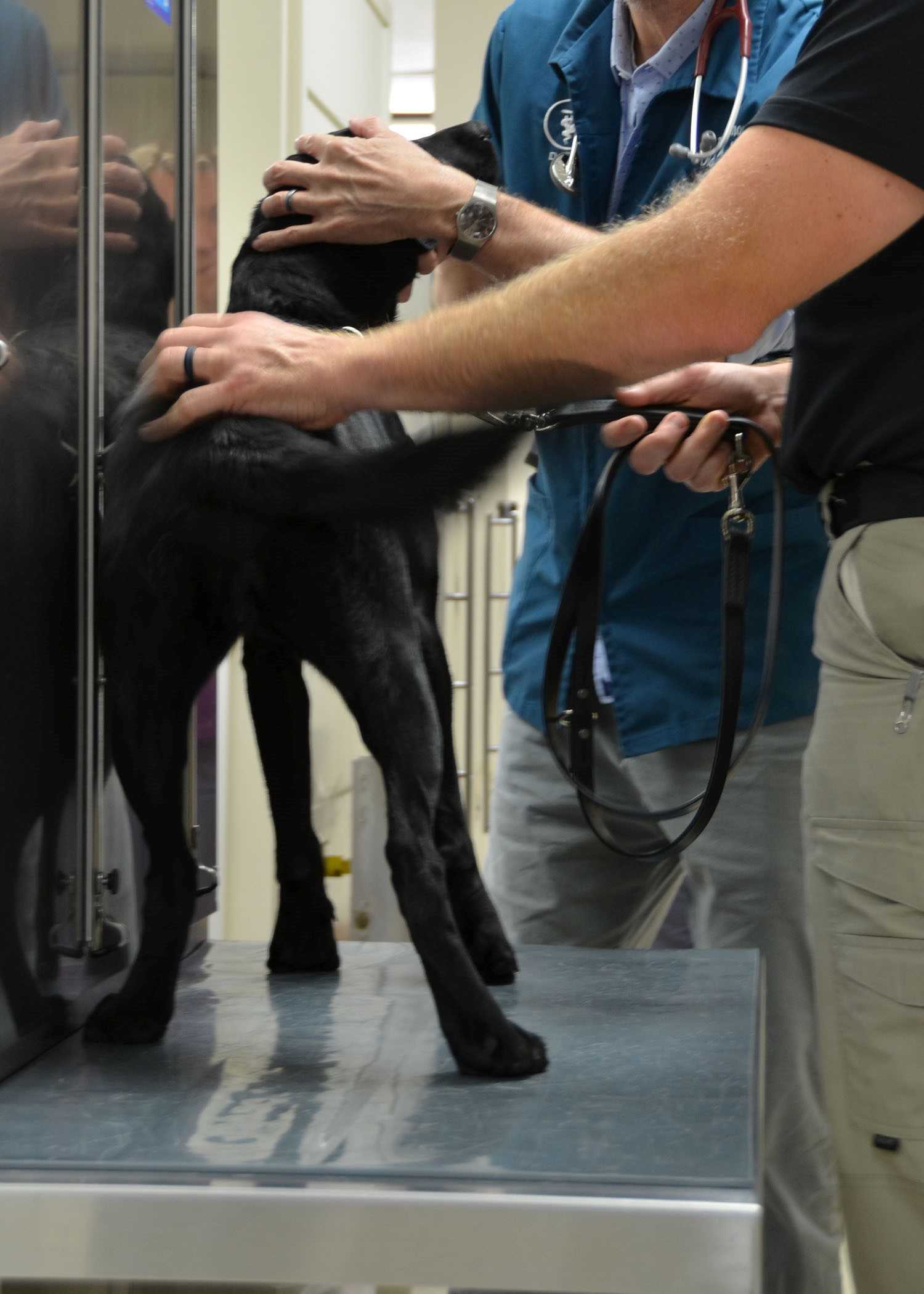
Suni being looked over by Dr. Drummond.
Other than allergies causing her eyes to water and some gunk that has to be cleaned from her ears, Suni is declared healthy and ready for class. She receives the remainder of her yearly vaccines and is sent home with some medication to help with her watery eyes and dirty ears. She bounces out of the veterinary clinic as wiggly and affectionately as she bounded in.
Next up is Indigo, who tries to leap from the exam table, and when that is unsuccessful, buries her head into the crook of K9 instructor Andy’s arm until her vet exam is done. Leaving the clinic, Indigo springs up onto the receptionist counter, front feet only, begging for rubs and treats. Instead of being admonished as impolite, she’s rewarded and encouraged to do it a second time! Our trainers actually like this behavior because she’ll need to be comfortable getting onto all kinds of different surfaces—like chairs, tables, or truck beds—in her line of work (of course, under the careful guidance of her handler). Even a trip to the vet provides a good learning opportunity for the new pups.
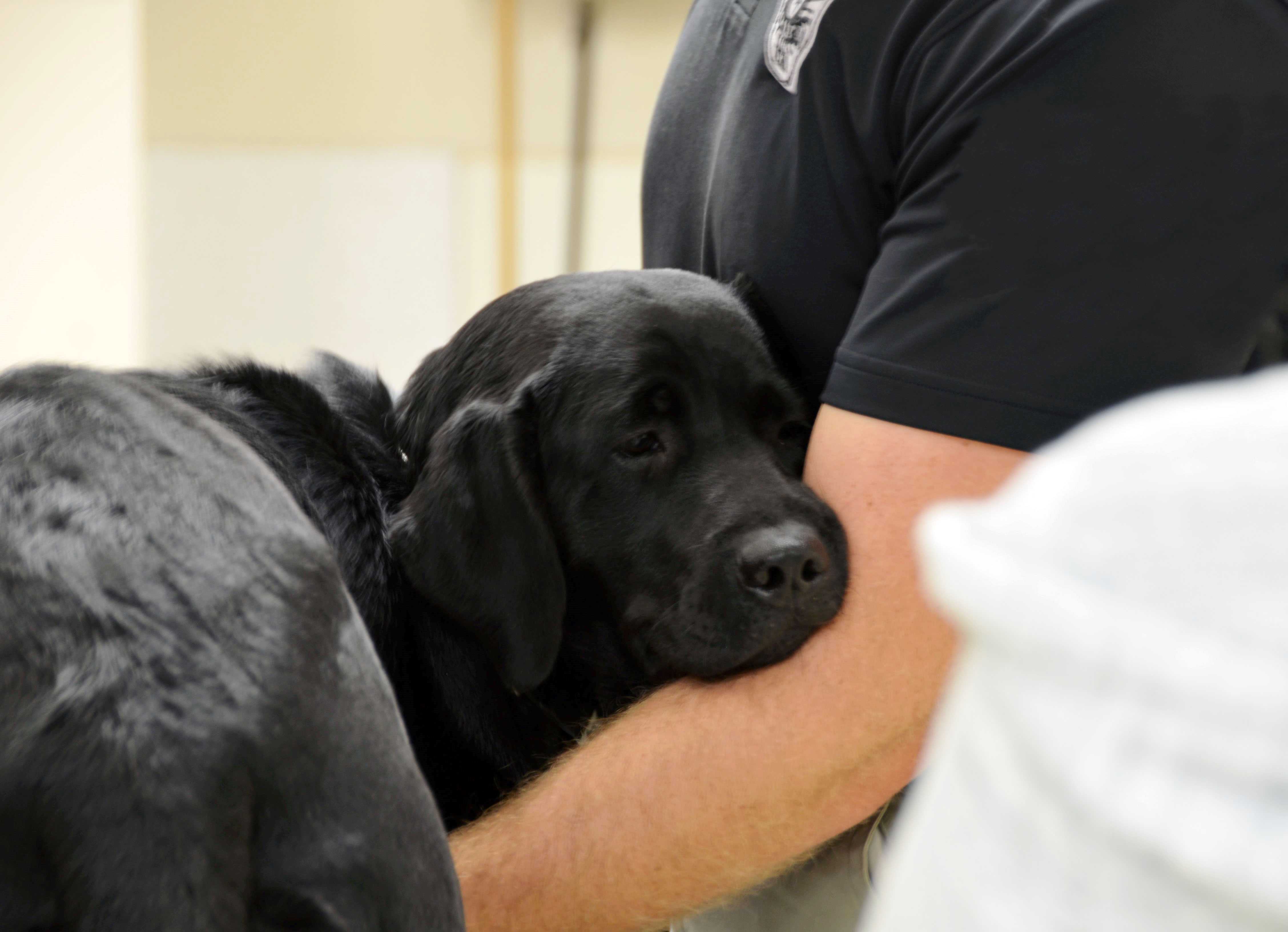
Indigo burrowing into Andy’s arms.
Freya, who would much rather ride shotgun in the passenger seat than in the state-of-the-art K9 van kennels, shows her spunk as soon as she enters the lobby of the vet clinic. Greeted by Dr. Drummond, she immediately assumes the puppy play position (paws and head low to the floor, rear-end raised high) and starts roughhousing with her new friend. Her big paws tap-dance across the linoleum floors in a chaotic beat as she tries to entice the vet and Andy to play with her. Once her exam starts, Freya stands quietly and lets Dr. Drummond look her over and administer her vaccines, but the expression on her face makes sure everyone knew how she feels about it.

Freya on exam table.
Nicole is the calmest puppy of the bunch—happy, sweet and beaming with joy as she makes her rounds saying hi to the clinic staff. She is very polite for her exam, sensitive to whatever Andy or Dr. Drummond ask of her. Like Suni, Nicole also has slight allergies, which the vet treats, and then he examines her paws.
The vet finds two small bumps, most likely Sebaceous cysts, between her second and third toes on each front foot. They don’t seem to bother her, but of course, as with any Agency dog, she’ll have a full workup done to be sure she’s healthy and that the cysts don’t need to be removed. Dr. Drummond takes extra blood to run additional tests out of an abundance of caution, and the K9 training staff should receive her results shortly.

Nicole being comforted by Andy.
All of the pups receive clean bills of health, although none are thrilled about having their ears cleaned or receiving their inoculations.
The pups are now ready for their first week of classes, where they’ll learn how to detect their first explosive odors.
Learning the Basics
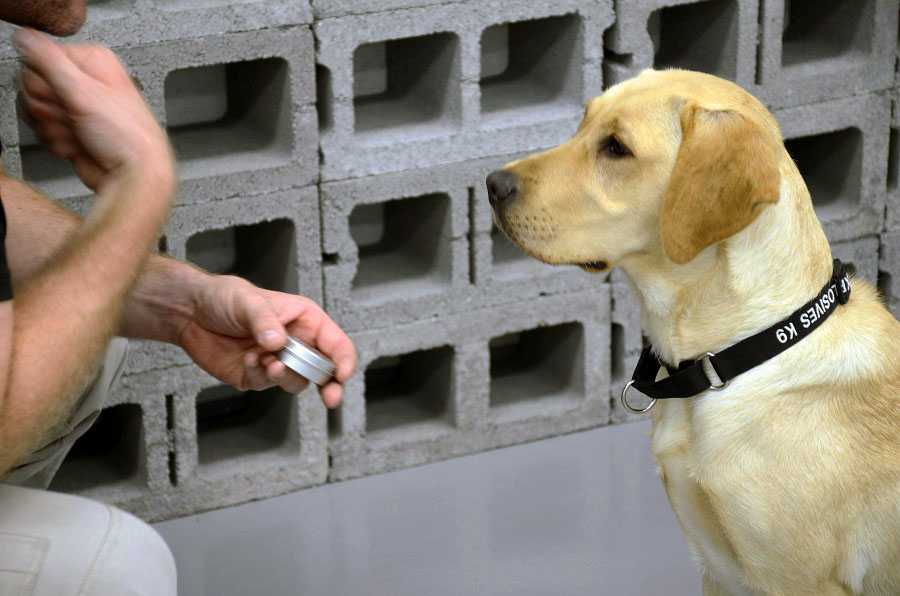
Heide’s first lesson.
The six puppies in CIA’s fall class – Suni, Heide, Freya, Lulu, Nicole, and Indigo – have no previous explosive detection training. So how to do you teach a dog to find a bomb? You start with the basics.
As the sun rises, Andy—the lead instructor for the fall class—and his training partner Steve, prepare CIA’s training center for the pups’ first lesson. They’ll do three lessons a day, every day, throughout the program.
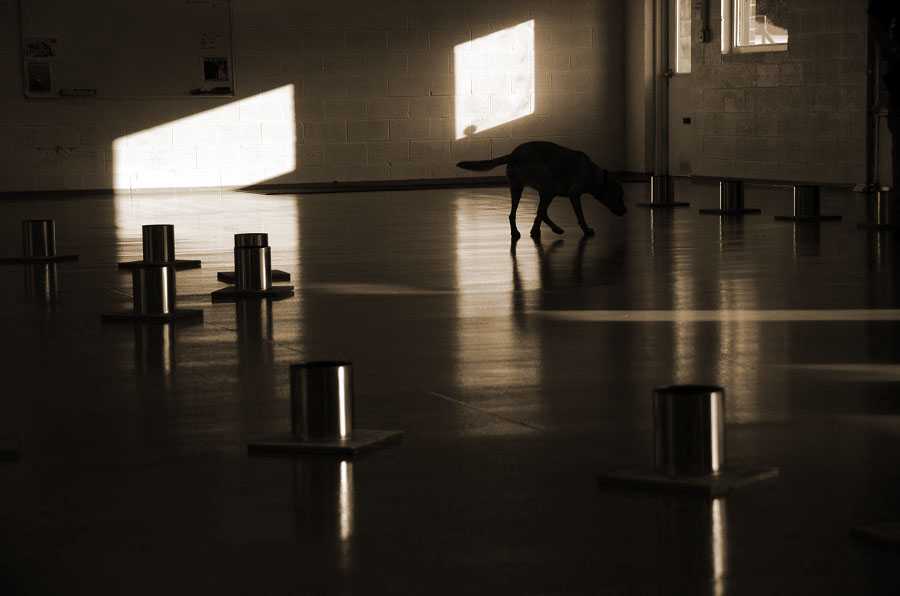
Heide at the training center, ready to begin her first lesson at sunrise.
CIA’s training program for new “puppy classes” lasts a total of 16 weeks. Classes are held seven days a week, even on holidays. The first six weeks the pups are focused on imprint training at our training center.
Directly following those six weeks, the dogs will be paired with handlers and the new teams will undergo another 10 weeks of advanced training.
The first few days of imprint training are spent in what the instructors call “the booth” – a small square area separated from the main training room by three, 4-foot-high cement walls and a gate.
The back of the booth is made of cinder blocks, with the openings exposed to hide small tins with odors for the dogs to find.
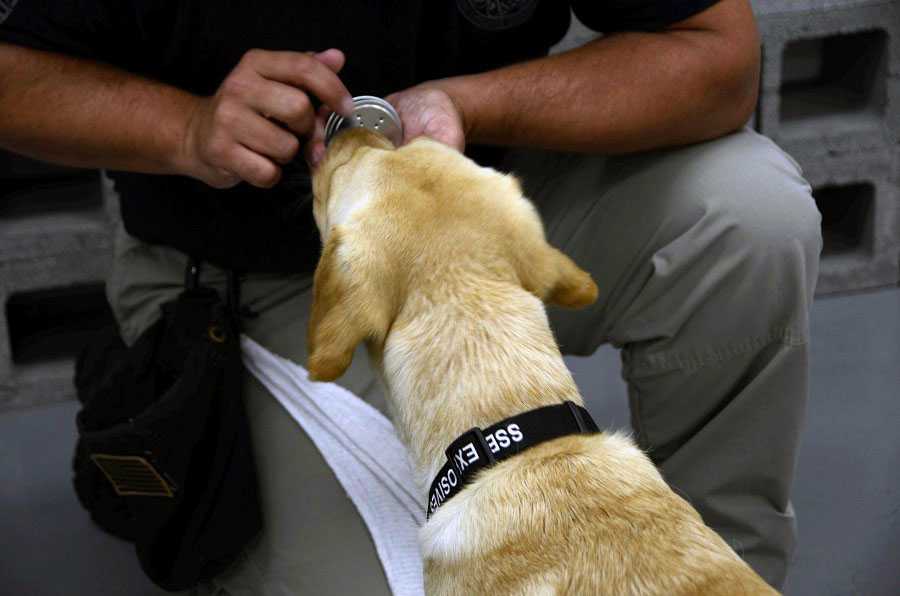
Heide sniffing a tin the trainer has presented to her.
Day one is spent teaching the pups the concept of sniffing on command.
The trainer presents the tin to a pup who, out of curiosity, sniffs it. The trainer then erupts into squeals of delight (sometimes cartoon voices too), jumps around, and praises the pup like the dog just found a pot of gold.
Then the pup gets some kibbles of dog food, followed by a lot of pats, rubs, and maybe even a game of tug-of-war… whatever the dog loves and gets excited about.
This process is repeated 35-45 times in a row.

Heide getting extra loves while training in the booth.
If the pup gets distracted or becomes disinterested, it’s up to the trainer to find a way to get the dog excited and happy to keep sniffing the tin.
The trainers’ number one rule: make it fun. “If the dog makes the decision to do a desired behavior on its own,” says Dennis, the lead trainer of CIA’s K9 unit, “they learn more, rather than the trainer making them do it.”
That’s why our program uses only food-based, positive reinforcement training methods.
The goal of day one? “Get the dogs to seek out the tin for a sniff on their own,” says Andy. “You want the dogs to start figuring things out, so whenever they give even the smallest try, they get a reward.”

Nicole eagerly awaiting the kibbles her trainer is getting out of the pouch.
The pups figure out within minutes that if they show interest in the little metal can that Andy or Steve is holding, they’ll receive a kibble of food. What they sometimes miss is that they need to sniff the can and not paw it, lick it, or push it like a button.
“Listen for the sniff,” instructs Andy. “When you hear the big inhale, that’s when you know they’re picking up the scent and not just nosing the can.”
Andy emphasizes that during the first week of training, the most important thing the trainers look for is a change in the dog’s behavior – whether it’s a tilt of the dog’s head, drooling, a pause in movement, anything that indicates the dog has caught the desired scent and is paying attention to it. Then reward like crazy. And repeat, repeat, repeat.
“Gotta keep them interested and engaged,” says Andy.
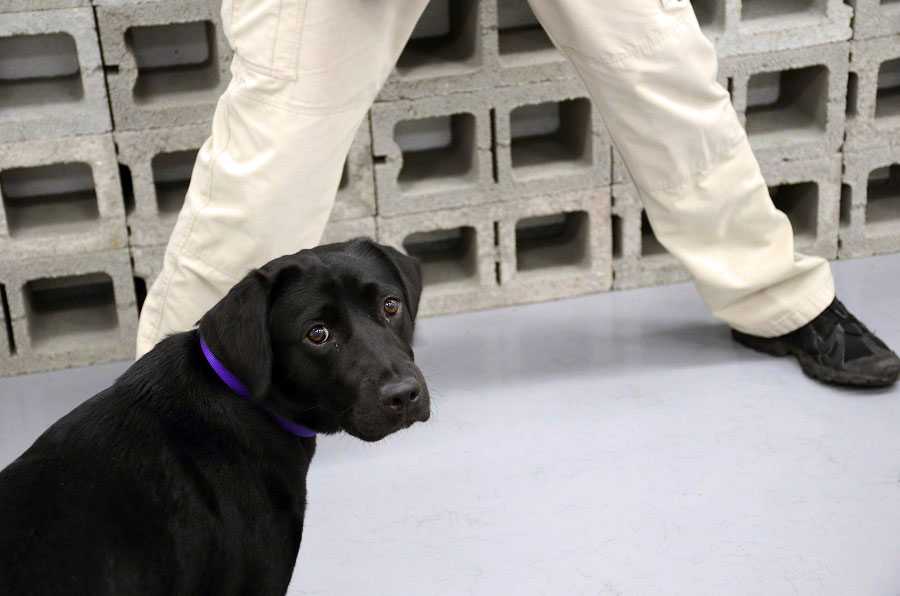
Lulu during her first lesson in the booth.
The next two to three days will be spent the same way; teaching the pups to sniff a tin the handlers are holding for a reward. Once they’re solid on that, they’ll learn a second scent.
Training moves fast after this. In less than six weeks, the pups will be able to successfully detect more than 20,000 different explosive mixtures!
What will the dogs learn next? Now that the pups know their first explosive odors, the trainers can teach them how to “seek” and to safely indicate that they’ve discovered a “hot.”
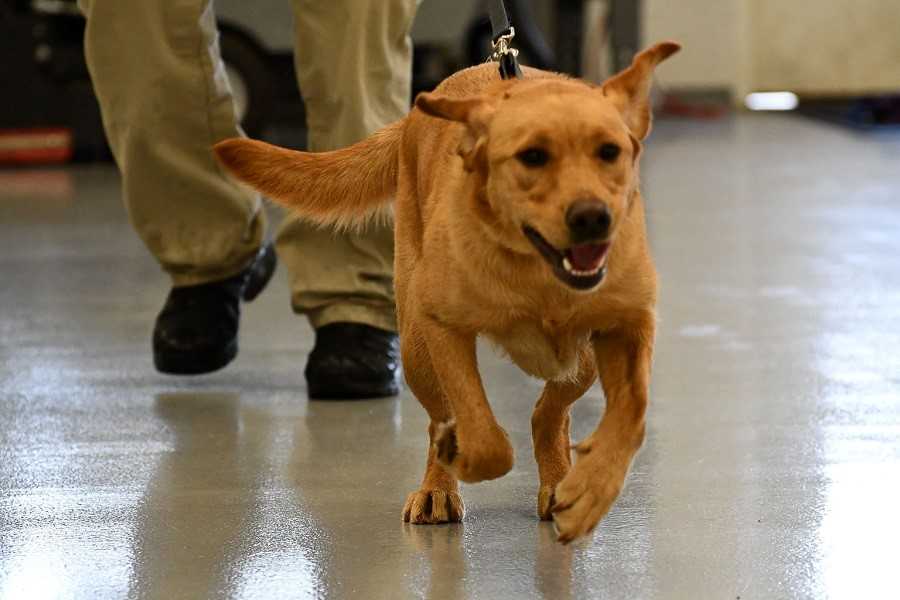
At the end of every training day, the pups get a special treat: A huge dog cookie! Nicole excitedly bounds after hers.
The Pups Learn "Seek" and "Sit"
The six young Labradors in CIA’s fall 2017 puppy class – Suni, Nicole, Indigo, Lulu, Freya, and Heide – have graduated from the booth and are now learning new scents out on the training room floor. The ladies performed so well in the booth, in fact, that they began their floor exercises two days earlier than most previous classes!

A trainer pets Heide before the start of a lesson.
As each pup enters the training facility, they scramble across the smooth epoxy concrete floor, feet going every-which-way, so full of excitement and spastic puppy enthusiasm that they can barely keep their paws underneath them.
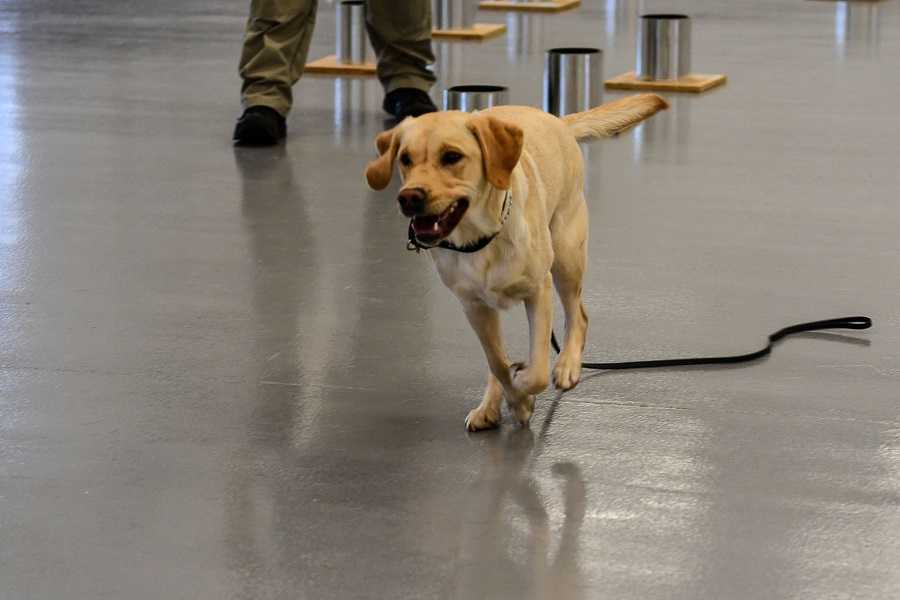
Freya bounds across the training center floor.
K9 instructor Steve walks Suni into the room and lets her off her leash. She spots Andy, the lead instructor, freezes, and stares at him. When Andy looks back at her, she gives him “the look.” Before he can react, she bolts across the floor at full speed, leaps off the ground onto his chest, feet first, then bounces off. While he regains his balance after being hit by a 60lb flying Labrador, she prances off back toward Steve, tail wagging, in a happy-dance canine swagger.
Suni loves to play as much as she loves to work!
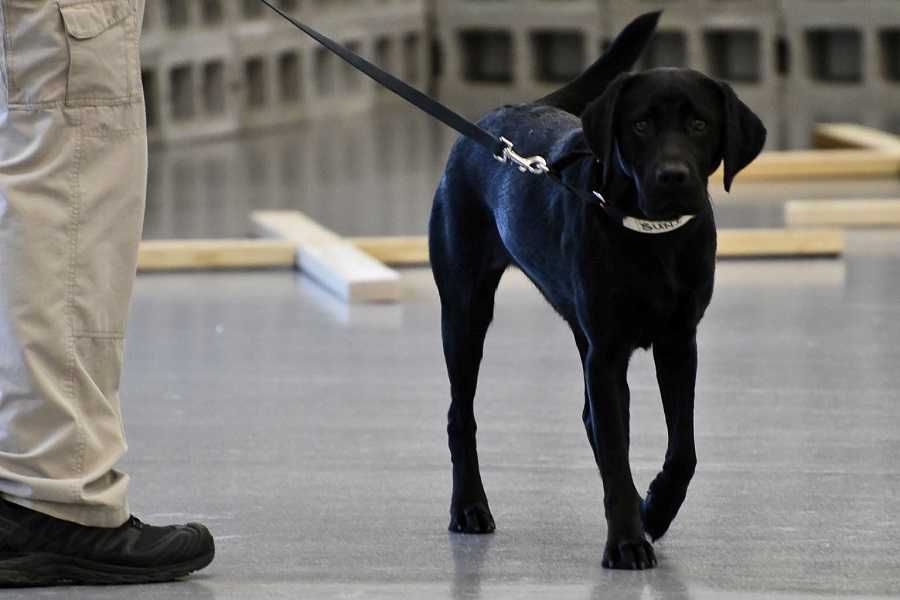
Spunky Suni is ready to work after some playtime with the trainers!
The first week of classes on the training room floor are focused on what the trainers call “line discrimination” – essentially the pups are learning to find the two scents they’ve been imprinted on in cans spread across the floor.
Remember the gallon cans the trainers used during their puppy evaluations? They’ll be seeing a lot of those for the remainder of imprint training. That’s because the trainers use those cans to form lines, circles, and various odd shapes for the pups to search.

Nicole listens carefully to the instructor as she searches a can-line for explosive scents.
The trainers place the tiny tins containing the scents into aluminum quart cans, which are then placed inside the larger metal gallon cans. As they add new scents for the pups to learn (i.e. be imprinted on) they’ll now do so using these cans.
The pups also learn two important concepts. The first is “seek” – which means to search for the explosive odor. The second is to “sit” when they find a “hot” (i.e. explosive odor).

Nicole takes a double-sniff after she catches the scent of an explosive in this can-line.
The dogs need a quiet, calm way to indicate to their handler that they’ve found an explosive scent. The trainers teach the pups to sit because when they find an explosive in real life, they don’t want the dogs to bark, pick up, or in any way disturb a possible bomb.
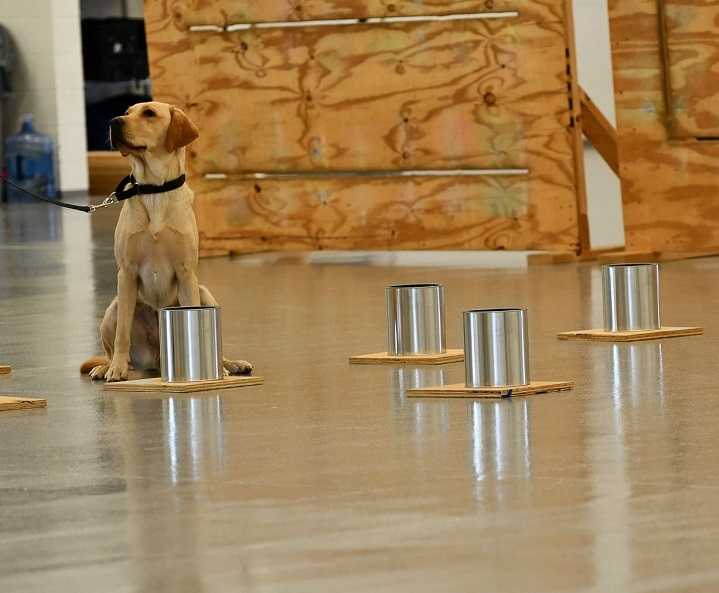
Heide sits after discovering a hot.
The cans are first arranged in straight lines. The trainers present a can to the pup by walking backwards and using their hand to show the pup where to sniff (kind of like Vanna White on Wheel of Fortune showing the puzzles to be solved).
It’s a lot more difficult than it looks. Every new handler is exhausted after the first day they run a can-line. The motion needs to be fluid and the movement precise – it’s like a choreographed dance between handler and dog.
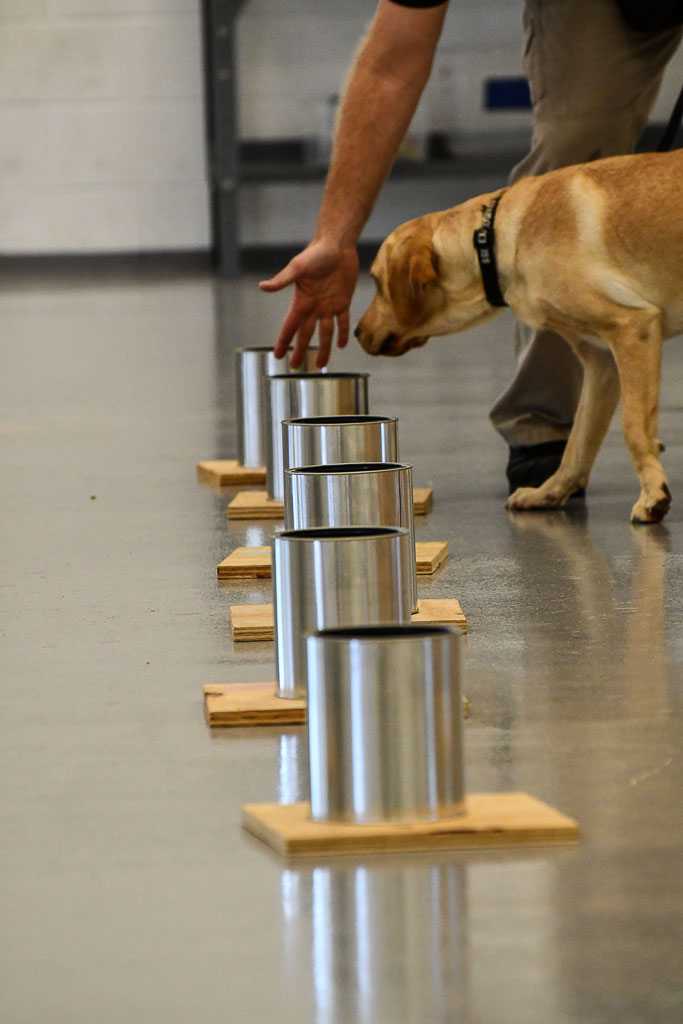
Heide follows the trainer’s presentation of each can as she seeks out explosive scents.
Andy runs Suni through the can-lines, and she catches on quickly, excitedly searching each can for the explosive scents.
Indigo and Steve are next. When she sniffs the can with the explosive scent and sits, Steve erupts into a high-pitched reverie of “Good girl!!! That’s my baby! Good girl, Indy!!!” and gives her some kibbles. Indigo is so excited she can barely contain herself. She stays in a sit, but her front paws tap-dance in a frantic beat in anticipation of a kibble.
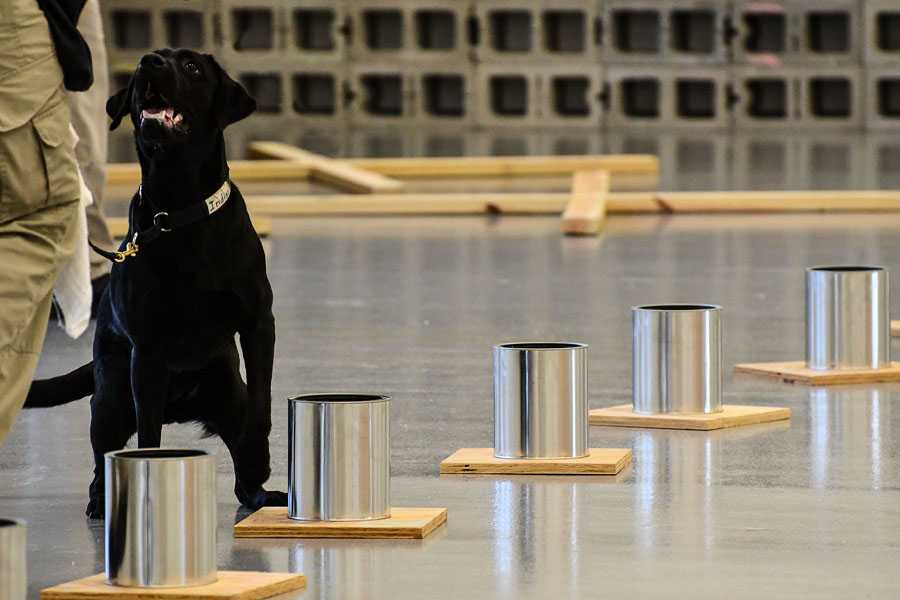
Indigo just found a hot and can barely contain her excitement as the trainer reaches for some kibbles to reward her good work.
Watching grown men, some of them former Marines, jumping around and squealing in high-pitched tones, dancing with dogs who are squirming, wiggling, and wagging like hamburgers are falling from the sky is hilarious and a bit startling the first time you see it. The trainers are pros at it. They have no shame. It’s all about getting the dogs excited and making sure they’re having fun while learning their new jobs.
Often new handlers, usually men, have the most difficult time with this part of the training. Someone who has been a police or military officer for most of their career usually isn’t accustomed to gallivanting around an open warehouse, clapping their hands and talking in silly, high-pitched cartoon voices. It can take some prodding from the more experienced hands, and seeing how the dogs respond (or don’t respond), to finally get the new handlers to break out their inner clown.
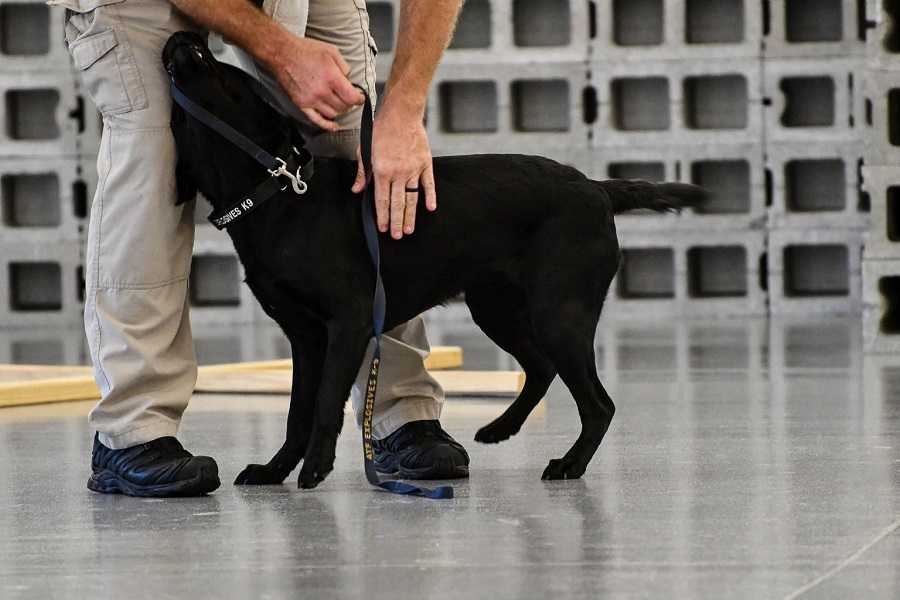
Indigo gets loves and rough-houses with the trainers after a session.
The pups all quickly learn that they need to sniff the cans and find the scents they’ve been taught. It’s amazing how fast they catch on.
Nonetheless, even when a pup is learning quickly, sometimes their heart just isn’t in it. When that happens, it’s up to the trainers to see if they can motivate the dog and make the job fun again. Sometimes, however, that doesn’t work, and the pup decides this just isn’t the job for them.
A Pup Leaves the Class
For our K9 trainers, it’s imperative that the dogs enjoy the job they’re doing. Sometimes, even when a pup tests well and they successfully learn how to detect explosive odors, they make it clear that being an explosive detection K9 is not the life for them. Such is the case for one of the fall 2017 “puppy class” pups.
We are sad to announce that Lulu has been dropped from the program.

Sweet Lulu.
A few weeks into training, Lulu began to show signs that she wasn’t interested in detecting explosive odors. All dogs, just like most human students, have good days and bad days when learning something new. The same is true during our puppy classes. A pup might begin acting lazy, guessing where the odors are, or just showing a general disregard for whatever is being taught at the moment. Usually it lasts for a day, maybe two.
There can be a million reasons why a particular dog has a bad day, and the trainers become doggy psychologists trying to figure out what will help the dog come out of its funk. Sometimes the pup is bored and just needs extra playtime or more challenges, sometimes the dog needs a little break, and sometimes it’s a minor medical condition like a food allergy requiring switching to a different kibble. After a few days, the trainers work the pup through whatever issue has arisen, and the dog is back eagerly and happily ready to continue training.
But for some dogs, like Lulu, it becomes clear that the issue isn’t temporary. Instead, this just isn’t the job they are meant for. Lulu was no longer interested in searching for explosives. Even when they could motivate her with food and play to search, she was clearly not enjoying herself any longer. Our trainers’ top concern is the physical and mental well-being of our dogs, so they made the extremely difficult decision to do what’s best for Lulu and drop her from the program.
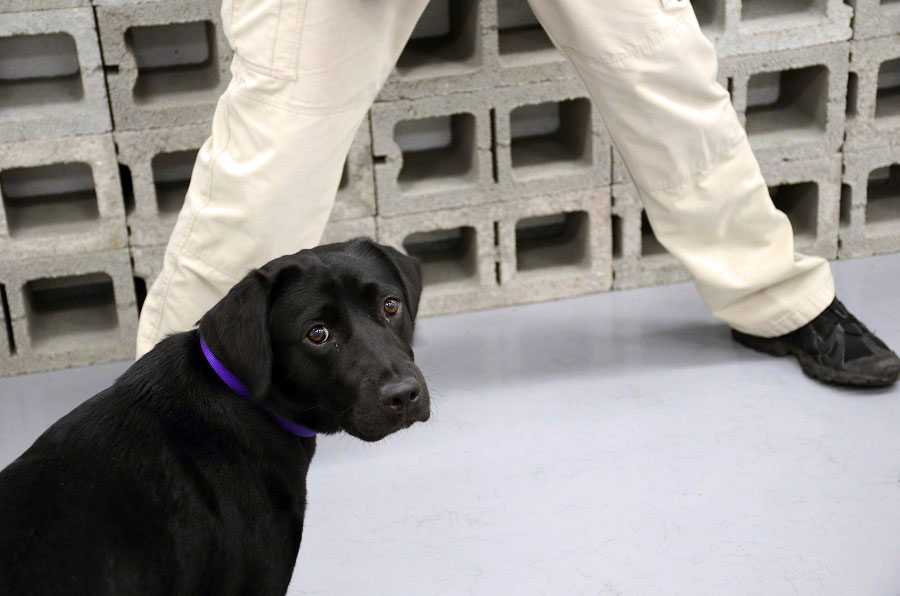
Lulu decided that sniffing for bombs just isn’t the life for her.
When a dog is dropped or retires from our program, the handler or handler’s family is given the chance to adopt them. Most handlers, of course, choose to do so. The dogs are their partners and have become members of their family, even after just a few weeks of training together.
Lulu was adopted by her loving handler, who had the chance to work with her during imprint training. She now enjoys her days playing with his kids, sniffing out rabbits and squirrels in the backyard, and eating meals and snacks out of a dog dish.
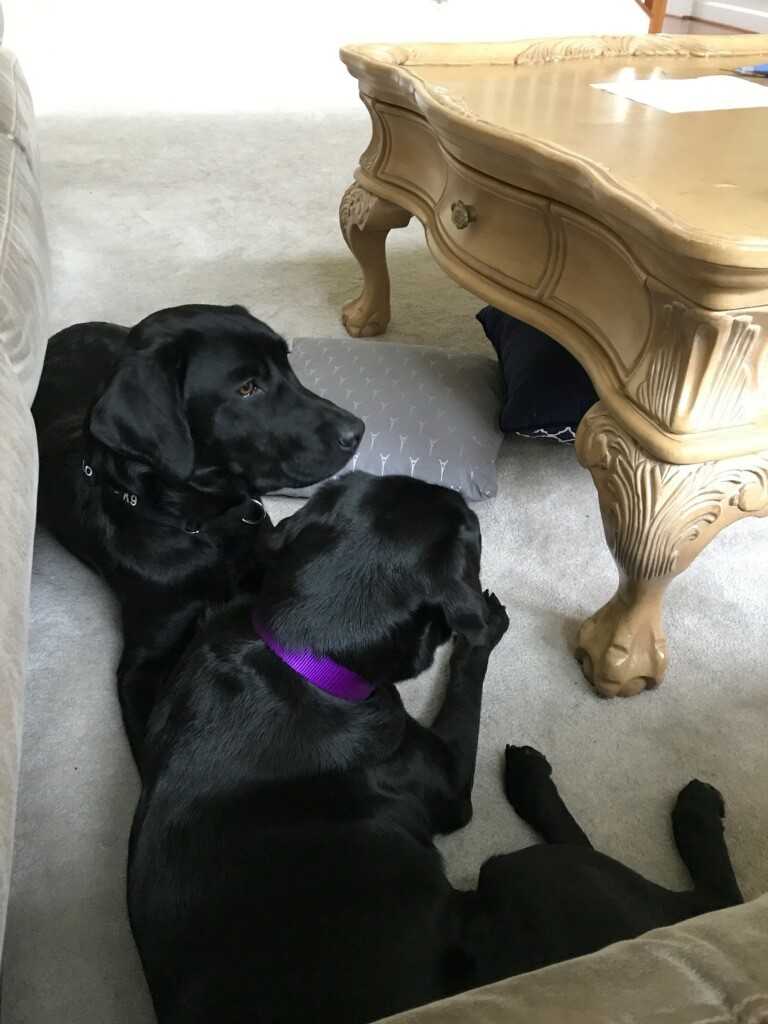
Lulu enjoying retirement with her new best buddy, Harry.
We’ll miss Lulu, but this was the right decision for her. We wish her all the best in her new life.
Although Lulu was adopted by her handler, her handler still needs an explosive detection K9 partner at work. The puppy class is still in the early stages of training, so our K9 instructors decided to bring on a new pup and try to catch them up to the rest of the class.
Who is this new K9 recruit, and do they have what it takes to catch up to the rest of the class? You’re about to find out.
A New Pup Joins the Class!
We’d like to introduce you to the newest member of CIA’s fall 2017 “puppy class”…
Meet Heron (aka "Harry")!
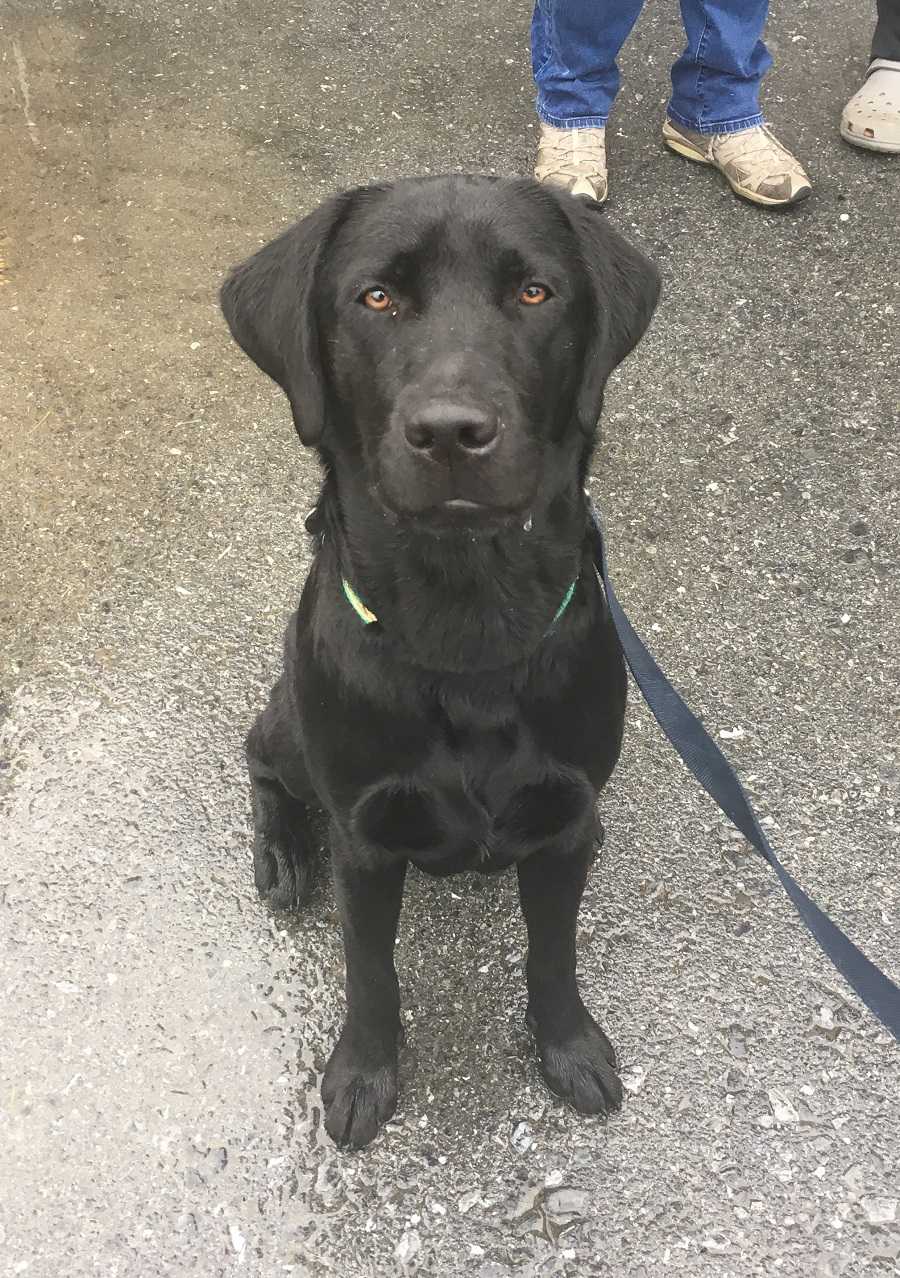
Harry, the newest member of CIA’s 2017 Fall Puppy Class!
Harry is a male black lab from Susquehanna Service Dogs. He’s a goofy, high-energy fella who loves to jump and play. At just over a year old, he’s the youngest pup in the class, but has an incredible drive to learn and is super smart.
Harry’s got a lot of work to do to catch up to the ladies, but our training staff is ready to put in the extra time and attention it will require. Here are some photos from Harry’s first week of training:
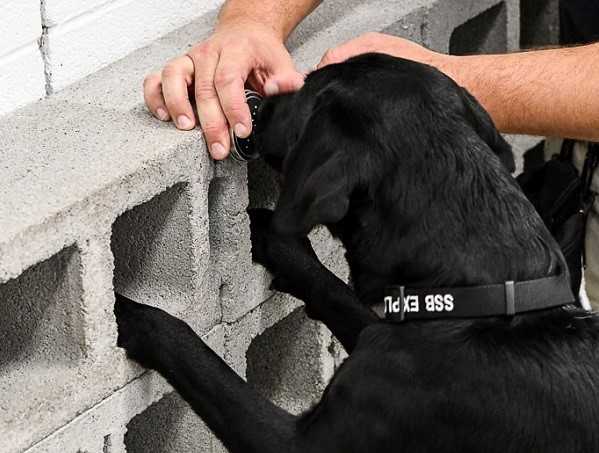
Harry jumps up to seek a target odor in a small tin held by a trainer.
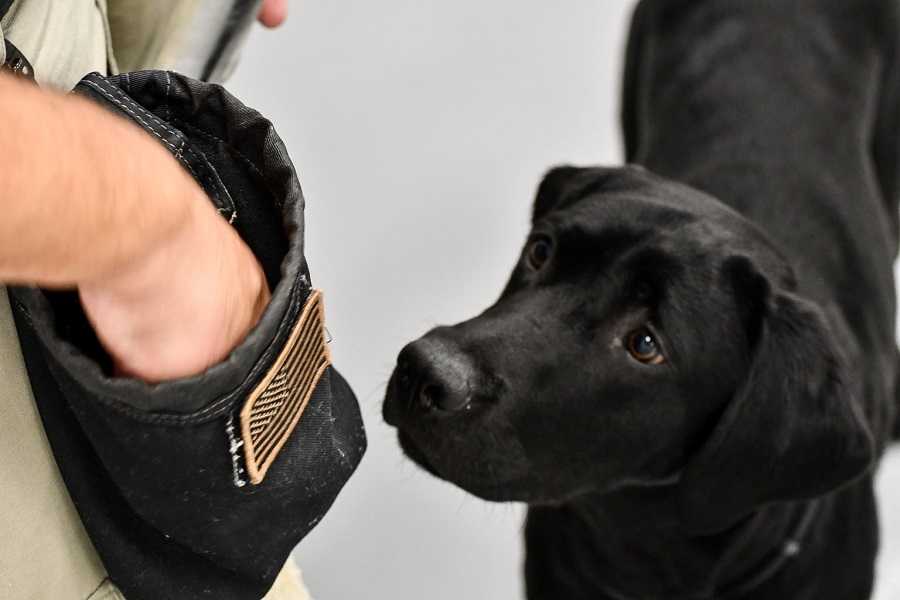
Harry eagerly waits for a kibble from the trainer after finding a target odor.
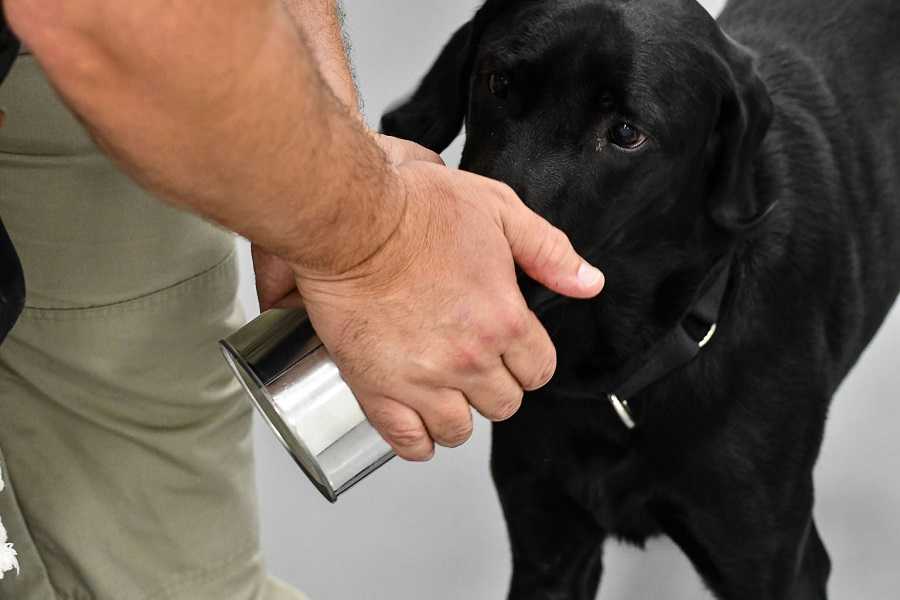
Harry learns to seek a target odor placed inside of the can.
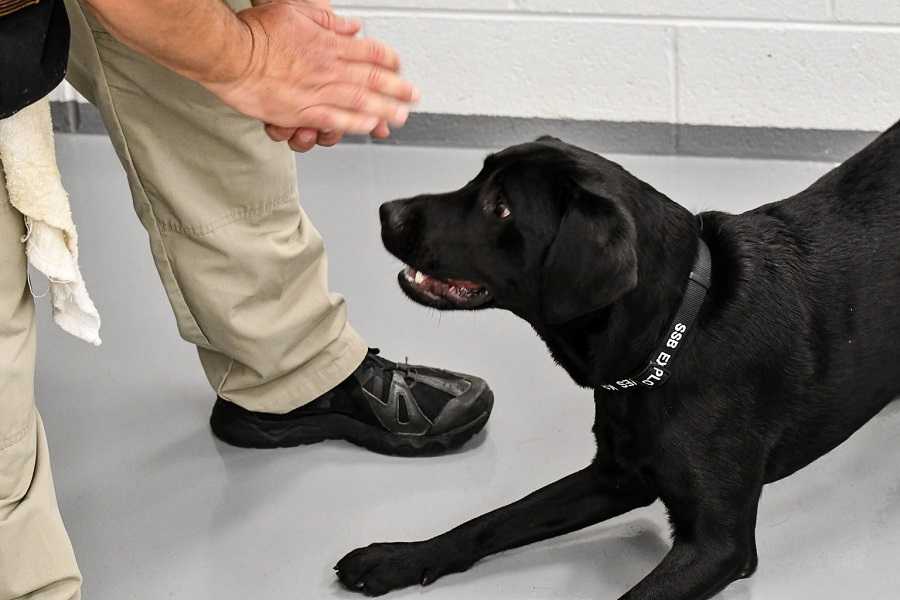
Harry enjoys some playtime with a trainer in the booth.
Soon, the class will finish imprint training and start advanced training with their new handlers. But first, it’s time for the handlers to get a little extra instruction themselves.
Training the Handlers
The pups have finished their imprint training and have officially been paired with their human partners!
The CIA handlers in this class are all “retreads” – handlers that have had a previous K9 partner. In fact, the handlers’ current K9 partners are retiring on the same day their new K9 partners graduate! As usual, the handlers and their families are adopting the veteran dogs, who will live out the rest of their lives being pampered and spoiled by their human families.
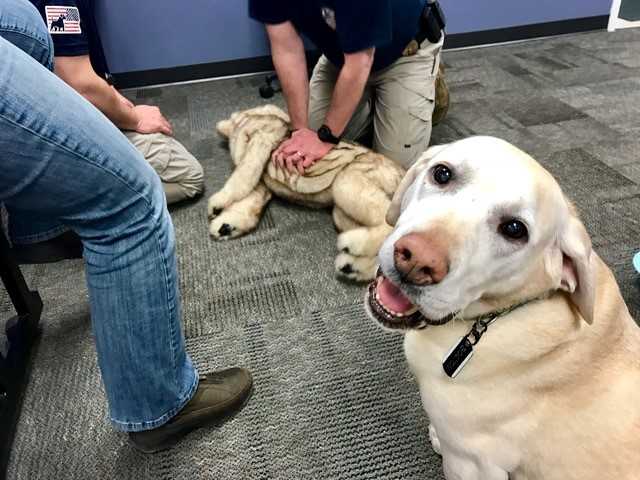
Boston, a senior yellow lab belonging to a guest lecturer, keeps a close eye on the handlers as they practice CPR on K9 mannequins. This is just one of the many things the handlers learn during their emergency K9 crisis care classes.
The first few weeks of lessons for the new K9-handler teams are spent in the classroom. As the pups continue to refine their skills, the handlers take advanced classes on subjects like firearms and explosives, as well as emergency veterinary care for dogs. The classes are taught by experts in their respective fields and provide hands-on experience for the handlers.
Soon, the new K9-human teams will apply everything they’ve learned so far in simulated exercises that test their skills and bond.
CIA K9s Level Up
The fall 2017 CIA “puppy class” is in high gear. The girls and new boy have learned all of their target odors and have been training with their new human partners for several weeks. They can now detect over 20,000 different explosive mixtures!
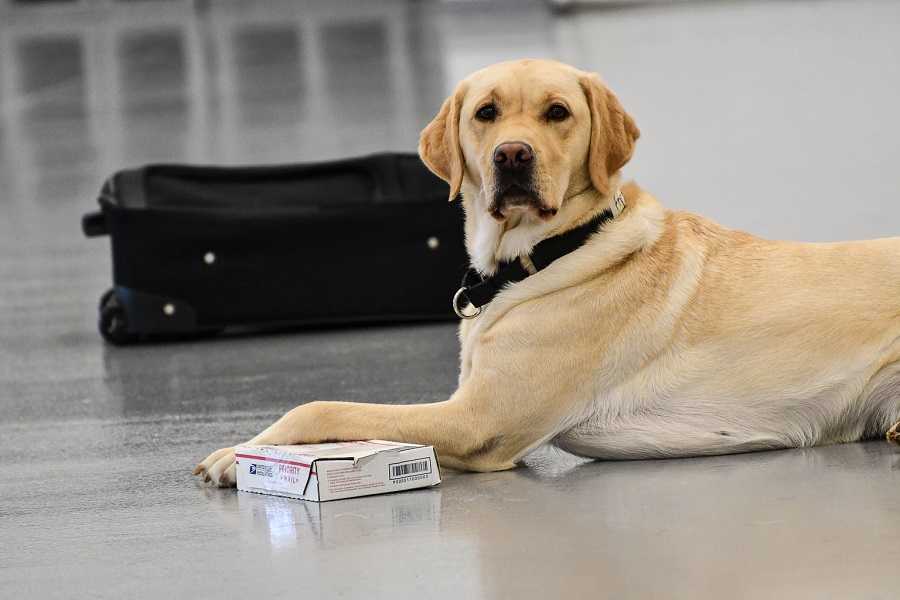
Freya takes a break after a successful search looking for explosive odors in luggage and boxes.
Dogs, clearly, have an exceptional sense of smell. They can pick out an explosive they’ve been imprinted with, even when that explosive is mixed with several other chemicals.
We’re often asked how it’s possible for a dog to learn only a few dozen scents yet be able to detect so many different explosives mixtures.
Our Lead K9 Trainer, Dennis, likes to explain it using what he calls, “the Beef Stew Metaphor”:
Let’s say you walk into a house and smell beef stew cooking on the stove. You might be able to pick out a few ingredients, but generally you smell the delicious stew as a whole. When a dog sniffs a pot of beef stew, however, they smell the carrots and salt and beef and celery and onions and paprika and anything else in it. They can pick out each ingredient and differentiate between them all. Yet to us, it just smells like stew.
If a dog was taught to indicate on the scent of carrots, for example, the dog would then indicate on the beef stew because it could pick out the carrots from the rest of the ingredients that make up the stew.
Not only do dogs have an incredible sense of smell, but it’s amazing how quickly they can pick up new scents! Our newest recruit, Harry, is no exception.
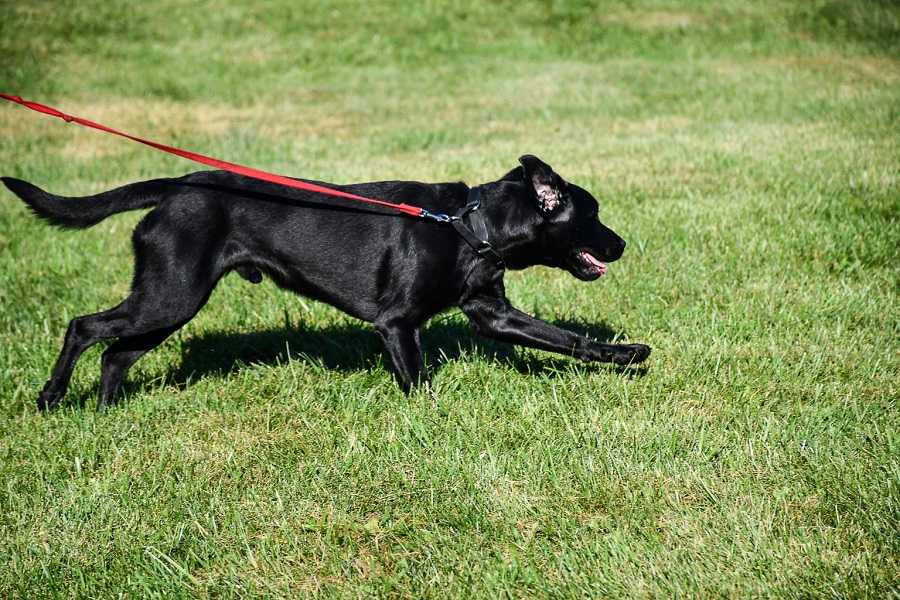
Harry eager to work during a practice field search.
As we announced a few weeks ago, the class has a new pup! Harry has been busy learning all of his explosive odors, which he’s mastered, and now he’s almost caught up to the ladies, who are practicing advanced search patterns and simulated exercises with their handlers.
Nicole, Heide, Suni, Indigo, and Freya have also been busy doing simulated searches on objects they’d likely encounter in the real world, like luggage, suitcases, and boxes.

Heide searches rows of cement blocks for hidden explosive odors, aka hots.
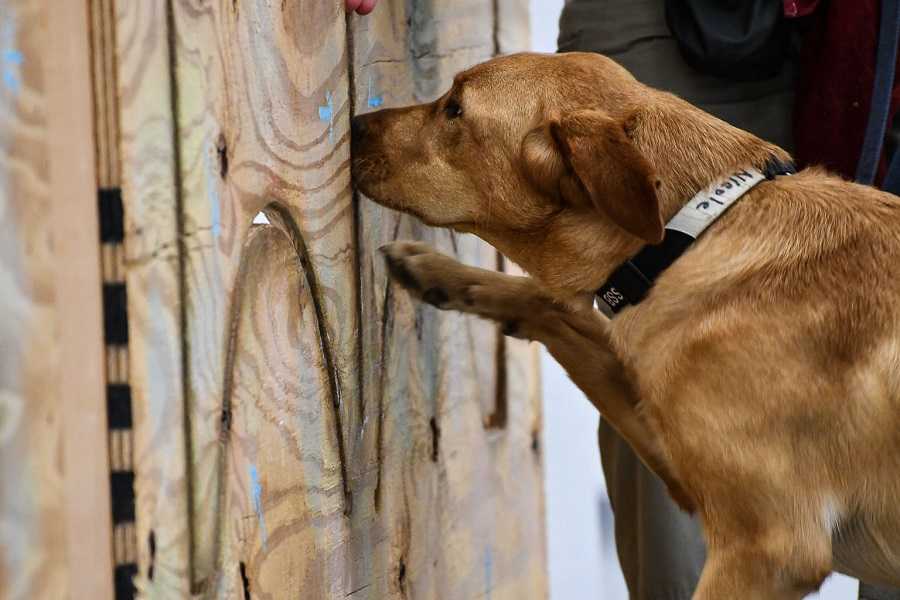
Nicole catches the scent of a target odor in the seam wall.
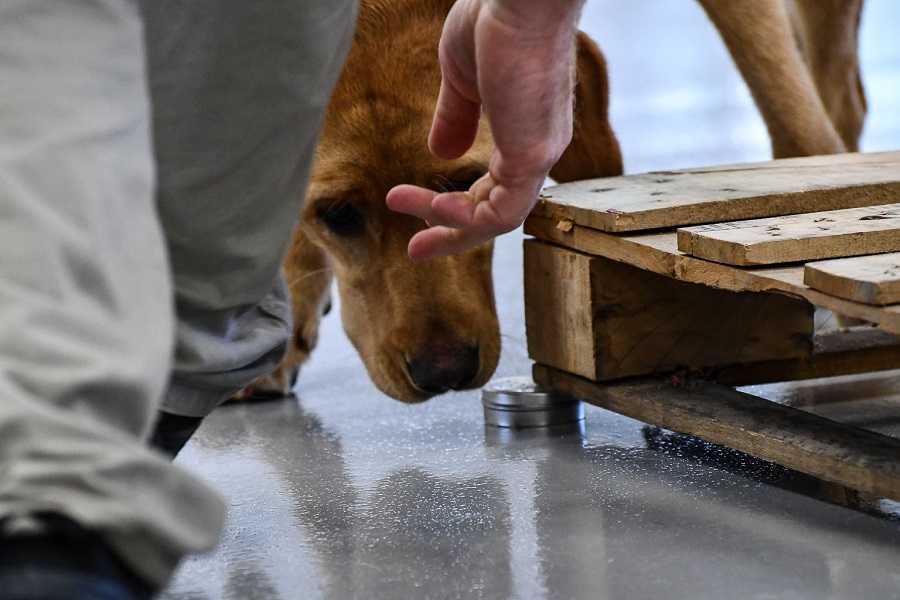
Nicole searches wooden pallets for target odors housed inside tiny metal tins, as her handler guides her through a search pattern.
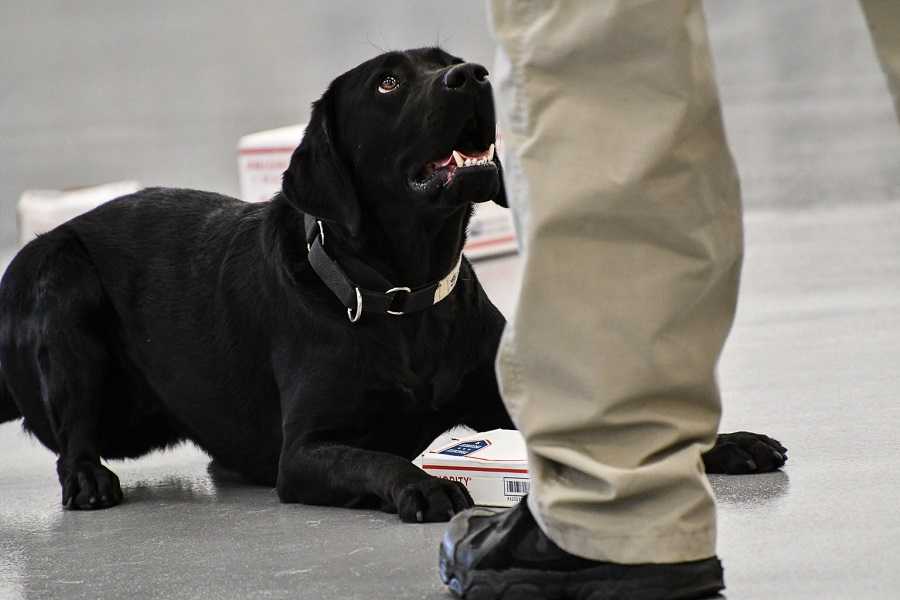
Suni finds a hot in the box and enthusiastically waits for her handler’s instructions.
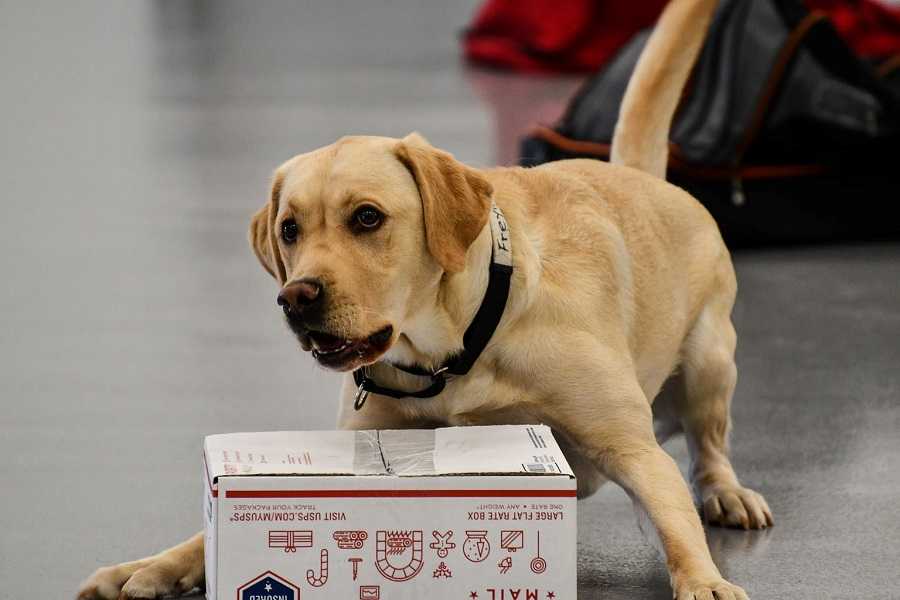
Freya is excited after she finds a hot inside the box during a simulated search.

Indigo glances at her handler as she examines a duffle bag, looking for hots.

Nicole examines bags and boxes, searching for hidden explosive odors during a simulated exercise.
Soon, the pups and their handlers will move on to searching bigger objects—like cars, trucks, and heavy machinery. Before they graduate, they’ll be able to successfully search not just large objects, but entire rooms and even warehouses for explosive odors.
The pups are eager to practice their search skills in a variety of different environments, as they continue to bond with their humans and learn to work together as partners.
Dog and Human Partnerships
It’s always a challenge when the pups transition from working with the trainers to working with their new handlers.
The handlers are used to working alongside their soon-to-retire dogs: most teams have been partners for 6-8 years. (CIA dogs retire no later than their 9th birthday). The pups, meanwhile, are used to the precise movement and energy of the trainers. It’s like changing dance partners. It takes a while for the new partnerships to get in sync.
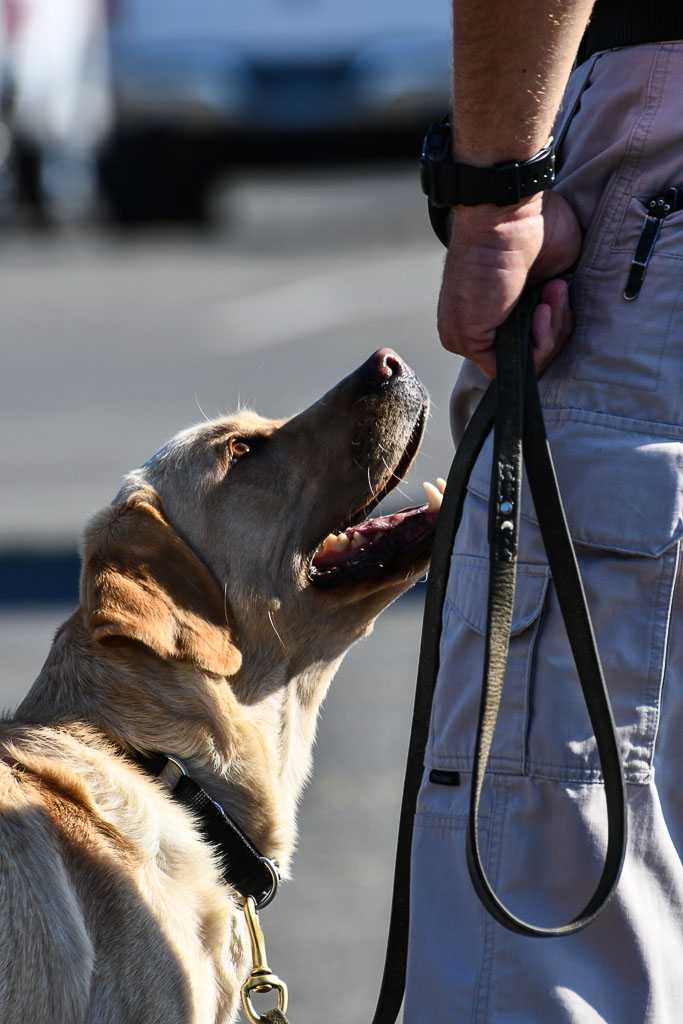
Freya
Our Lead K9 Trainer, Dennis, often talks about this “dance” between handler and dog.
“Watching an experienced K9-handler team should look like a dance,” says Dennis. “The handler should move through a search area with a smooth, fluid, rhythmic motion, presenting with their hand productive areas for the dog to search. This helps alleviate going too slow or too fast and also keeps the dog interested and focused in its search.”
Having a dog for a partner is a unique experience – different than working with a human partner and different than having a pet dog.
“Taking your K9 partner with you everywhere builds a different kind of bond than you get with a pet,” says Dennis. “You literally take them everywhere you go: into every establishment you go in to, on planes next to you, into war zones. It’s an amazing experience.”
An experience that Dennis and the other K9 officers wouldn’t trade for anything. But there is a downside: “Your job is finding bombs.”

Heide
For CIA’s K9 officers, working side-by-side with a dog, doing work that they’re passionate about and that makes a difference for our nation, is an honor. The gravity of the work our K9 officers perform on a daily basis in order to protect the Agency and our country makes the job rewarding, but also extremely challenging. This is why the handlers and pups undergo such extensive training and evaluation.
The exercises during training get more difficult as the teams progress through their advanced courses, preparing them for their final certification tests and graduation. Recently, the teams practiced a variety of vehicle and room searches.
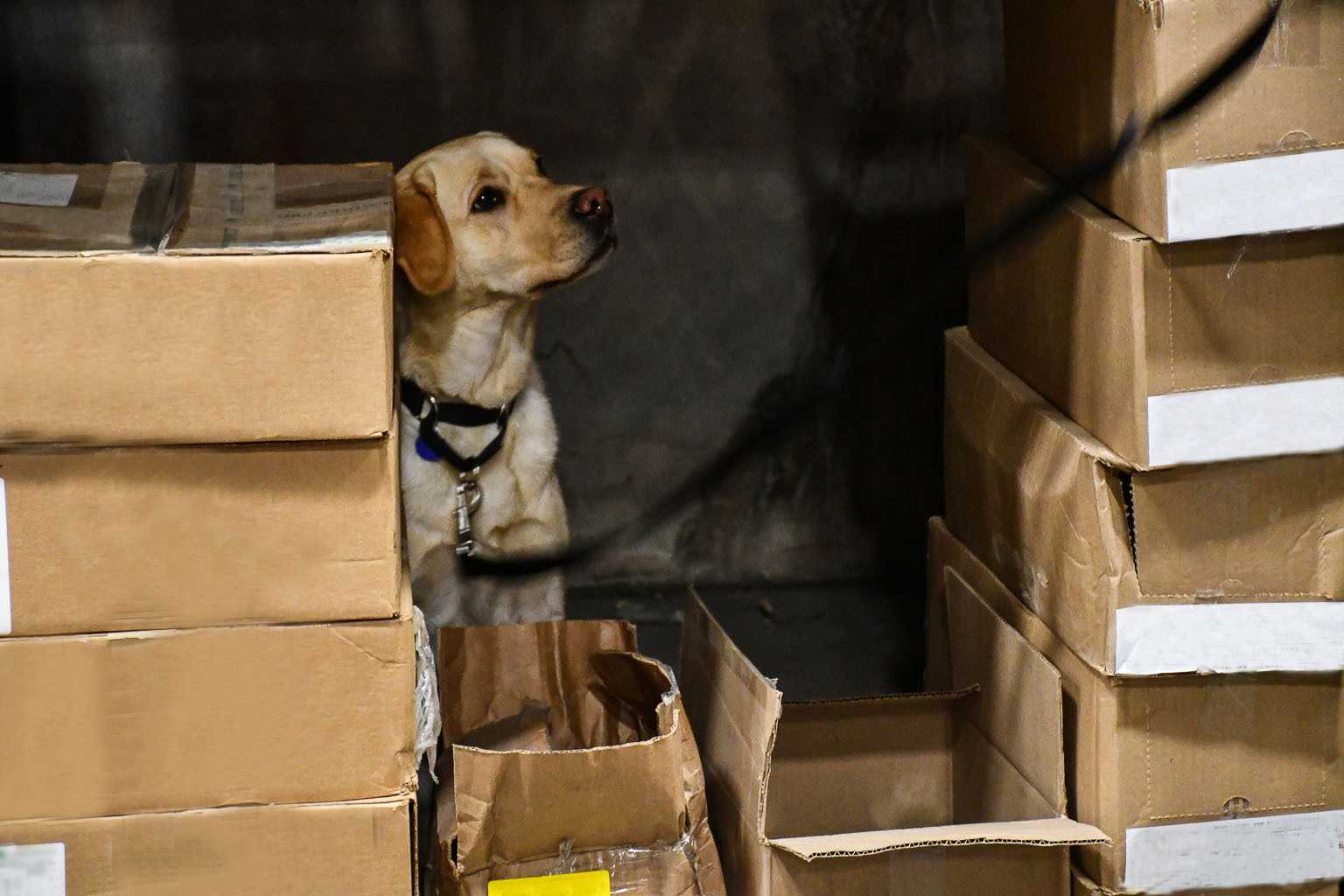
Freya sits after finding a hot while searching boxes in a warehouse during a training exercise.

Suni searches a car for explosives during a training exercise.

Nicole sits after finding a hot during a car search.
Advanced Searches
During advanced training, the trainers create simulated exercises for the pups and handlers to practice and refine their skills while searching all kinds of different objects in a variety of environments.
This includes searching large objects such as cars, trucks, and trailers.

Heide searches a car trunk for explosives.

Nicole searches a car for explosives. She quickly finds the training tin containing the explosive odors stuck to the underside of the vehicle.
The pups also practice searching in a range of settings like office rooms, hotel rooms, and warehouses.
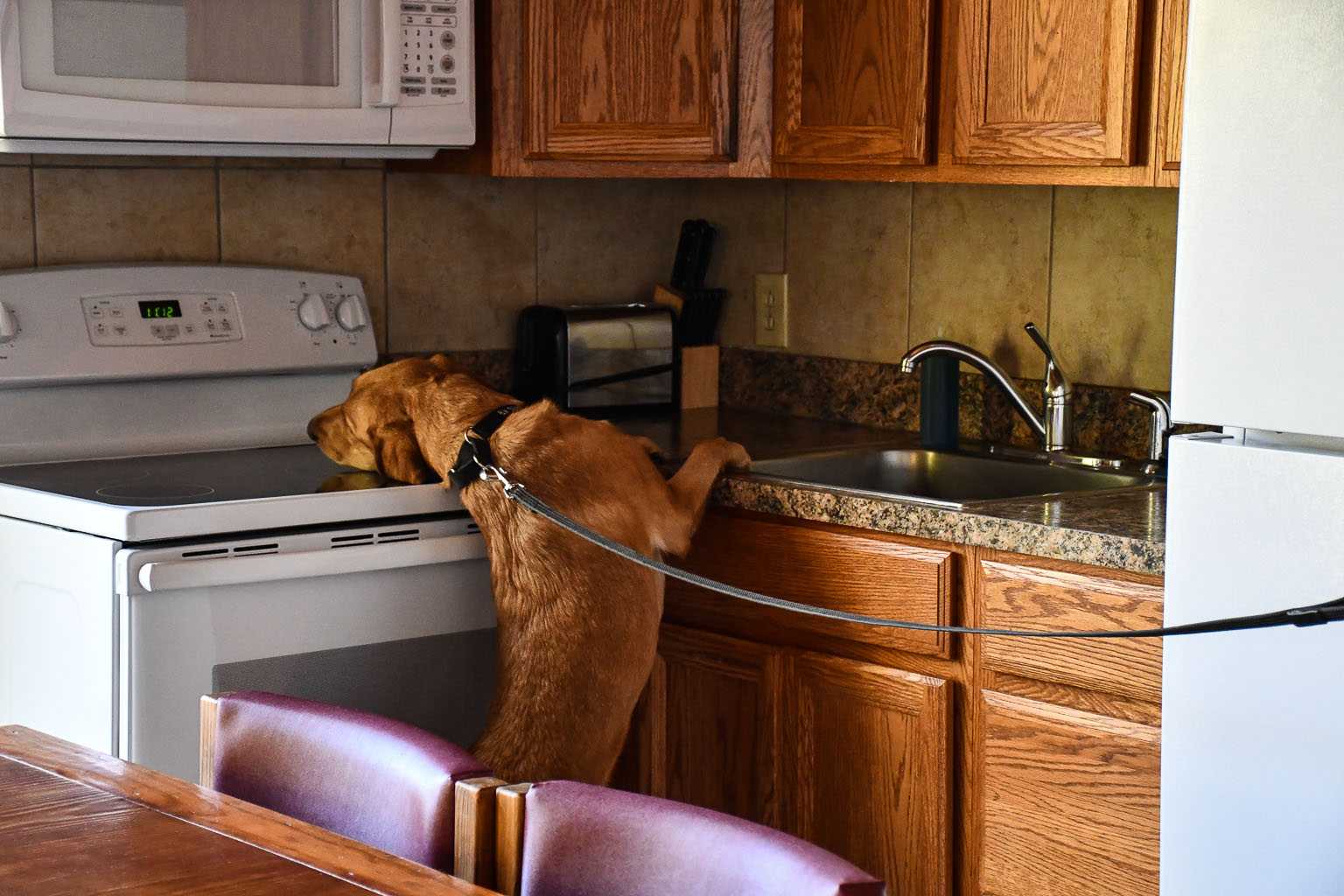
Nicole searches a hotel room for explosives.

Heide searches a hotel room for explosives.
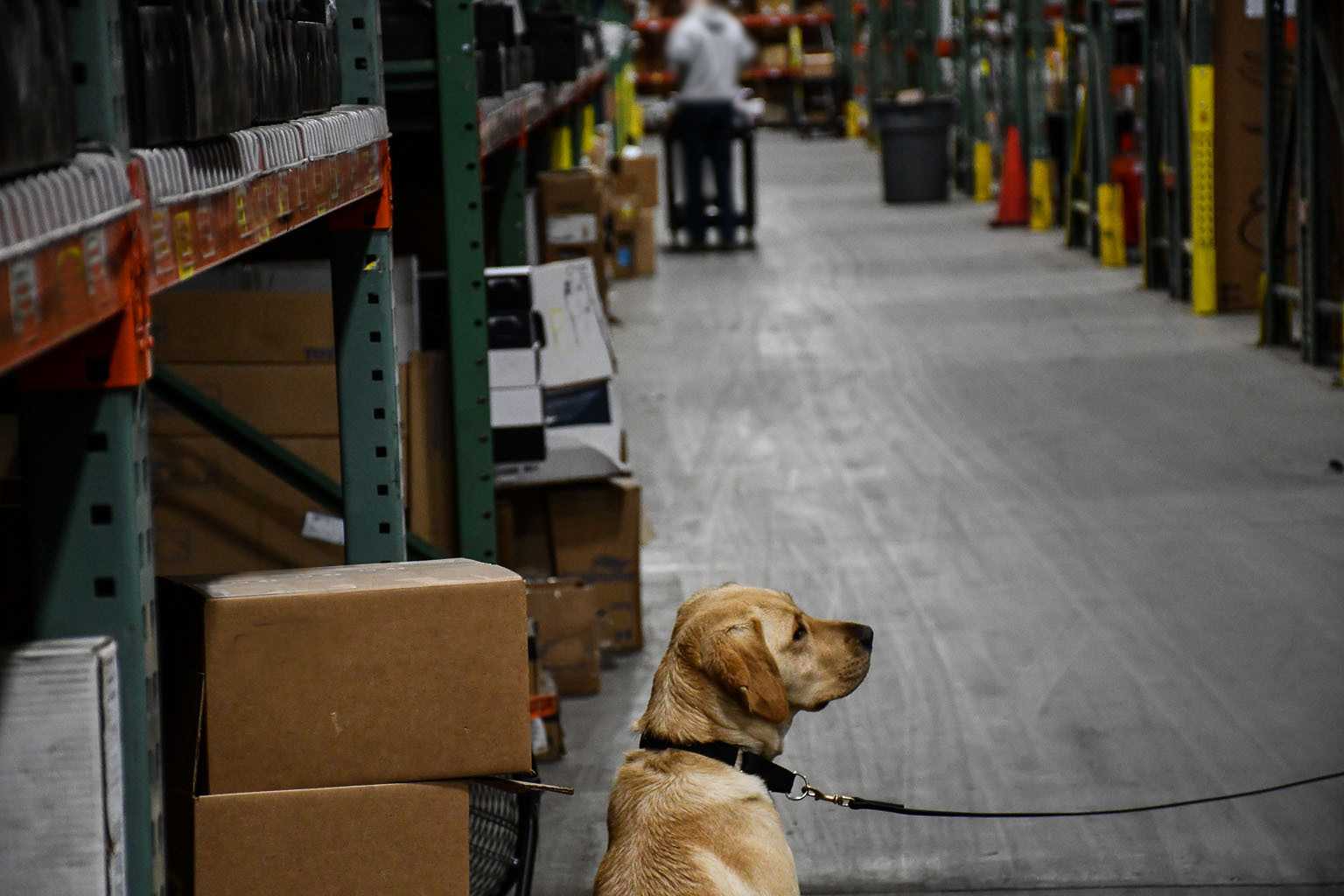
Heide searches a warehouse for explosives..
It can be challenging for the pups to transition from searching can-lines, cement blocks, and luggage to these larger items and arenas. The search patterns are different and sometimes it takes the dogs a while to learn that searching something like a car or an entire warehouse can be productive (i.e. that they’ll find a target or “hot” odor and get a food reward).
To keep the pups motivated, the trainers start the dogs out with easy search patterns and multiple hots.
As the handlers and dogs focus on the task at hand, K9 trainer Steve reminds the handlers to “make it fun!” A K9 officer’s job is extremely serious work, but the dogs respond best when they’re enjoying their work. It’s up to their handlers to keep the pups motivated.
“Your energy and attitude runs straight down the leash to the dog,” says Steve. “If you’re having a bad day and come in grumpy, the dog will pick up on that and behave accordingly.”

Freya just found an explosive odor while conducting vehicle searches.
As the pups and handlers improve their search techniques, the trainers make the searches longer and more challenging, including using multiple vehicles or several rooms, and fewer hots.
Eventually, the pups will search multiple rows of cars with only a single hot, as well as several rooms containing no target odors. This helps teach them to pace themselves properly to increase their endurance for long searches; an essential skill for any explosive detection dog.
As the pups and handlers finish their training, they’re preparing for their final evaluations. Once they’ve passed all their certification tests, it’ll finally be Graduation Day!
Puppy Graduation Day
It’s been four months of intense training for our newest K9 recruits, but all of that hard work has finally paid off. The CIA Fall 2017 “Puppy Class” is officially graduating!
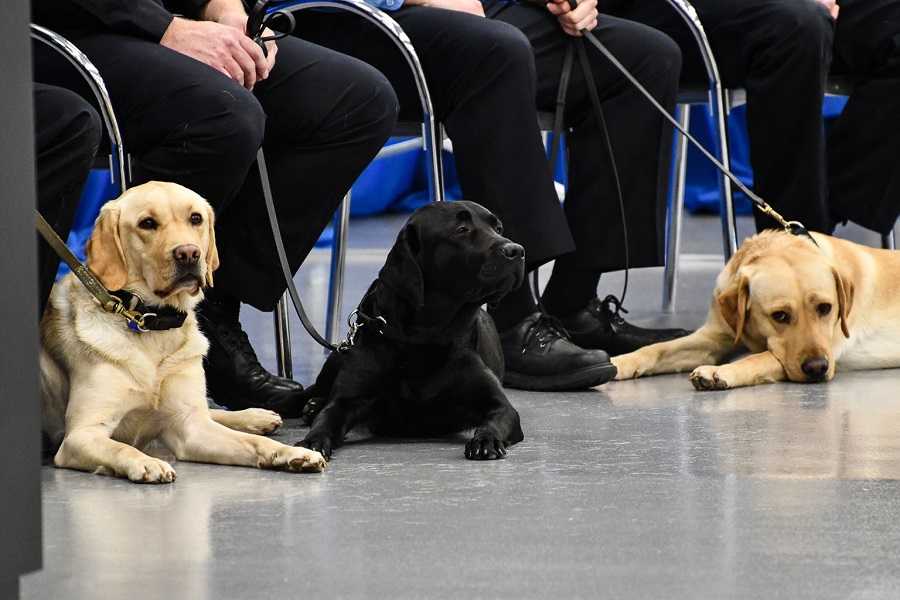
Freya, Indigo, and Heide during the graduation ceremony.
In order to graduate, the pups and handlers first had to pass two national certification tests: one administered by the Bureau of Alcohol, Tobacco, and Firearms (ATF) and another run by the United States Police Canine Association (USPCA). These tests are the gold standard for explosive detection dog certification.
CIA K9s Nicole, Indigo, and Freya all passed their ATF and USPCA certification tests; Freya and her handler were also awarded the class’s “Top Dog Award” for scoring 298.68 out of a possible 300 points on her USPCA test. Heide, who belongs to Frederick County Fire Marshal in Virginia, aced her certifications as well.

Freya playing with her graduation gifts after the ceremony.

Nicole getting belly rubs from the handlers and trainers during the graduation ceremony.
Harry, who joined the class in week 5—after Lulu, the now infamous Labrador Retriever, left the program—had a lot of catching up to do in order to graduate with the class. We’re thrilled to report that he passed all of his certification tests and has officially graduated! Harry, who shares a home with spunky Lulu, is a proud member of the Fairfax County Police Department.
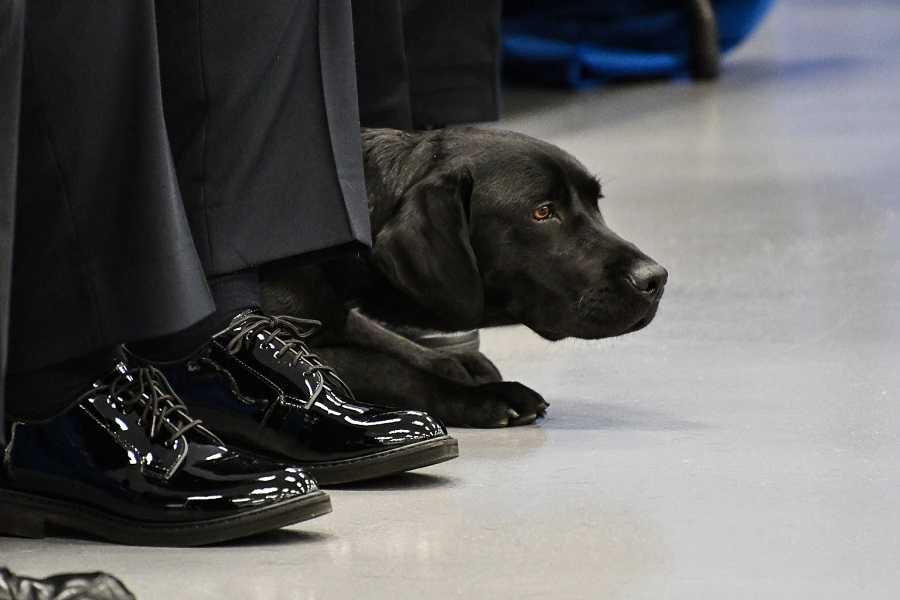
Harry peeking out from behind his handler’s legs during the graduation ceremony.
Unfortunately, there was one dog that did not graduate.
Due to circumstances beyond his control, Suni’s prospective handler was unable to complete the fall 2017 class, which also meant Suni couldn’t finish the second part of her training. Suni’s puppy raisers (the family that raised her until she was 1½ years old) requested that they be allowed to adopt her if for any reason she didn’t complete the program. There were no other CIA K9 handlers that currently needed a new K9 partner, so the decision was made to allow Suni’s puppy raisers to adopt her. Suni is now home with her original family, who was thrilled to get her back! We all miss the smart, silly, sassy Labrador, but we’re so happy that she gets to live out her life in such a wonderful, loving home.
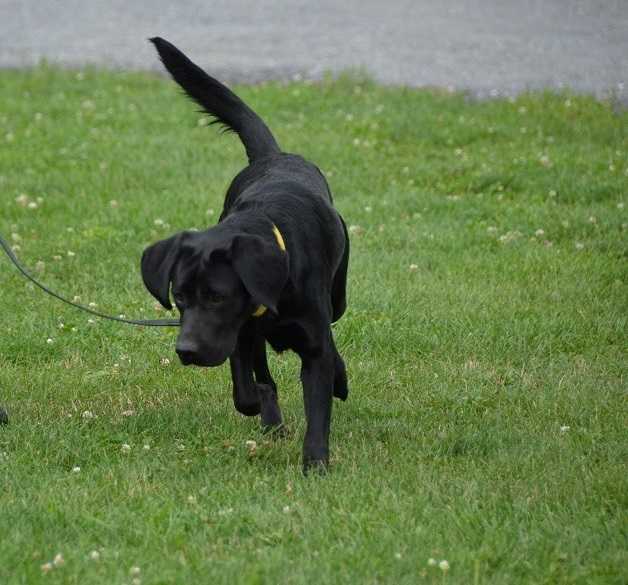
Suni romping in the grass during her initial evaluations at Susquehanna Service Dogs.
Passing the Torch:
For CIA K9 handlers, graduation day is often bittersweet. This year was no exception.
Each of the three CIA handlers in the fall 2017 “puppy class” had a current K9 partner. Tradition has it that on the day their new K9 partner graduates, their old K9 partner retires.
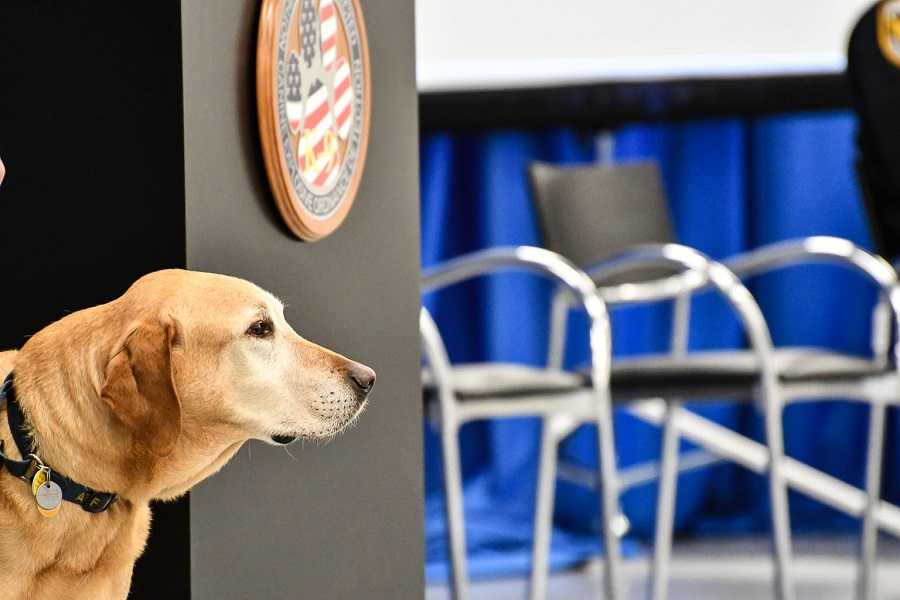
Osmond, one of the retiring CIA K9s, looks out at the crowd from the podium during the ceremony.
Most of our dogs work for 7-8 years. We usually get them when they are between 1–1 ½ years old, and we retire the dogs no later than age 9. The dogs begin living with their human partners from the first day the handlers report to class.
After working with them seven days a week for eight years, it’s pretty hard to separate a team. Just about all of our dogs retire with their handlers and their families. If a handler cannot adopt their retiring dog due to a family situation or other reasons, then the option is given to another handler in the K9 unit. Since CIA’s K9 officers love these animals so much, you will hardly ever hear of a dog retiring outside of the unit.
All three retiring CIA K9s are being adopted by their current handlers.
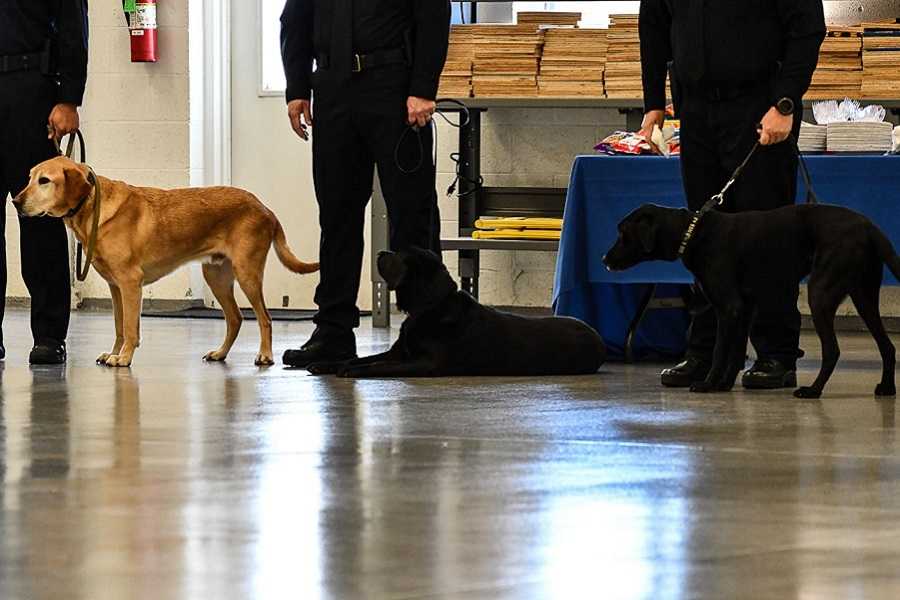
Osmond, Lucy, and Gears waiting for the retirement portion of the ceremony to begin.
Because the retired K9s are no longer employed by the Agency, their veterinary care can no longer be covered by the government. Medical care and other assistance is offered to our veteran dogs by a program called Paws of Honor, a non-profit that was started by one of the local veterinary practices. Paws of Honor helps provide retired working dogs with necessary medical care, as well as routine physicals and other items that allow us to show our gratitude to these wonderful animals that have given so much of their life to protecting ours.
Even though the handlers are adopting their retiring dogs, knowing this is the last day you’ll be working side-by-side with your partner of eight years is difficult for every handler. They’re excited to begin working with their new K9 partners, but they’ll nonetheless miss working alongside their old partners every day.
Here are the three CIA K9s retiring this fall, dogs who have dedicated their lives to serving and protecting this country:
K9 Gears:
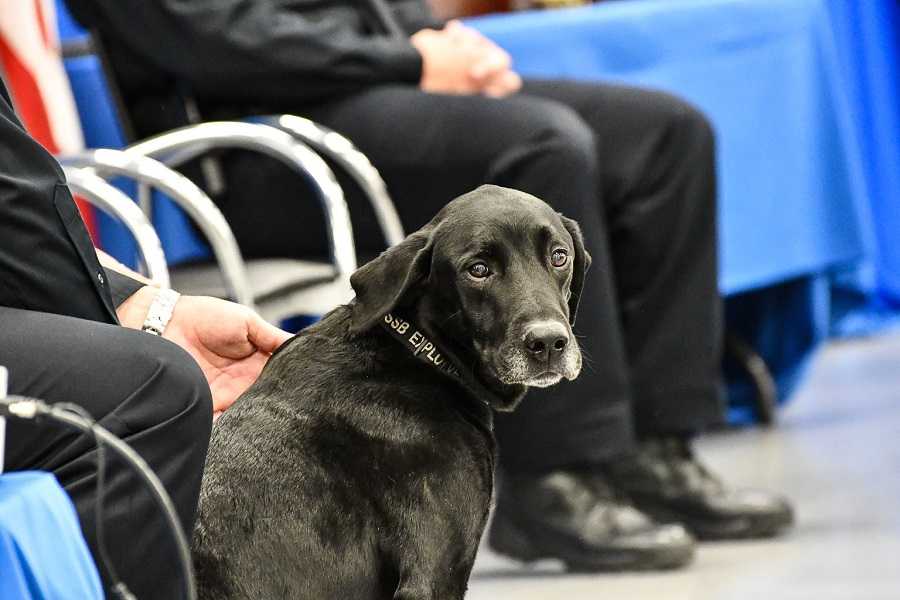
Gears during his retirement ceremony.
Gears, an 8 ½ year-old black Labrador Retriever with greying cheeks, was in the very first class that graduated from the CIA Training Center. Before CIA had its own K9 training program, our dogs were trained at ATF. Gears spent over 750 days overseas during his career. Gears, who loves the water, has swam in over 30 states, as well as the Atlantic and Pacific Oceans. Even in retirement, Gears has no problem swimming circles around his new protégé and housemate, K9 Nicole.
K9 Lucy:
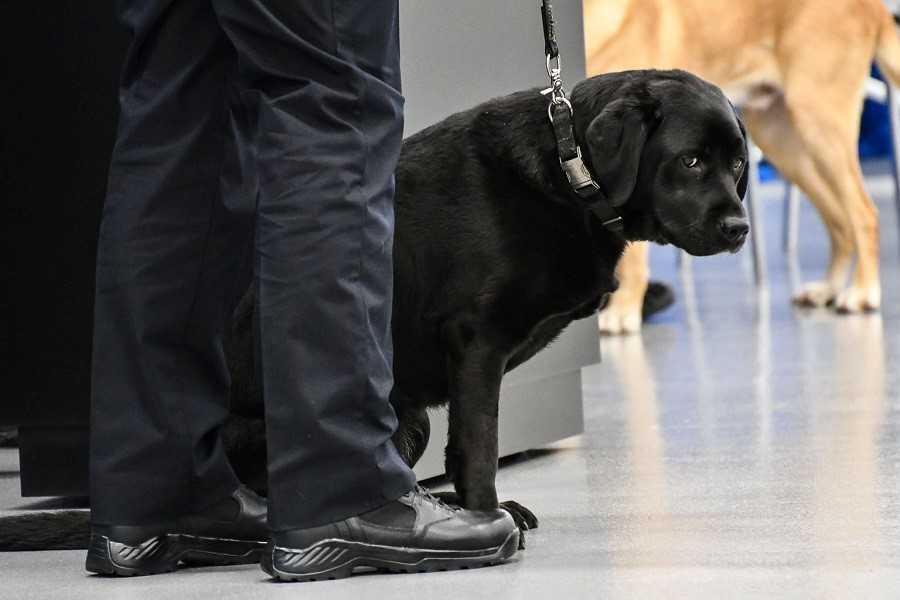
Lucy during her retirement ceremony.
Lucy, a 9 year-old black Labrador Retriever, was originally an Ambassador Dog for Puppies Behind Bars. She spent the first three years of her life traveling around the country helping to promote the Puppies Behind Bars program, before coming to CIA and becoming an Explosive Detection K9. Lucy has worked in challenging locations overseas six times, helping to protect lives, properties, and buildings for us. Unlike her K9 colleague Gears, Lucy hates the water, especially baths. Lucy shares her home with her new pal, K9 Indigo, and the two love to play and roughhouse together.
K9 Osmond:
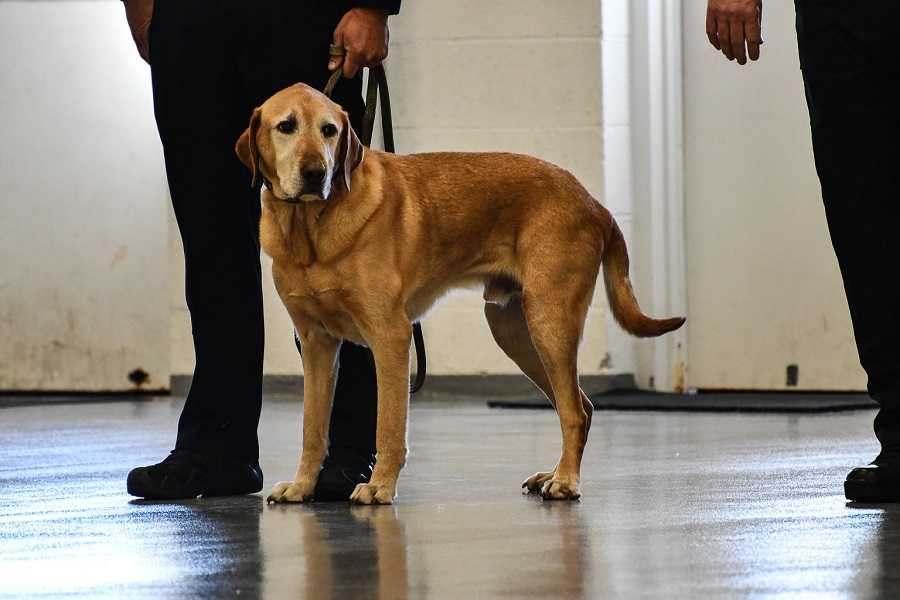
Osmond stands with his handler during the retirement ceremony.
Osmond—a 9 year-old, golden-hued, Labrador Retriever with a greying face—was one of the last CIA dogs to graduate from the ATF training program, just prior to CIA starting its own training center. Osmond has won numerous K9 Explosive Detection awards over the years, and he has served overseas many times. Osmond is a silly, sweet, loyal dog who is excited to share his home with several four-legged friends, including his newest buddy, K9 Freya.
* * * * *
During the graduation ceremony, the handlers and their retiring dogs are presented with a CIA plaque and shadowbox containing photos, their badge, and other mementos in honor of their service to our country.
The retired dogs sit quietly, heads held high, a wise calm much different than the boisterous puppy antics displayed by the younger, soon-to-be K9 graduates. The crowd, made up of family, friends, and colleagues – all those who make the K9 program possible – cheer for the veteran dogs as they are honored for their service.
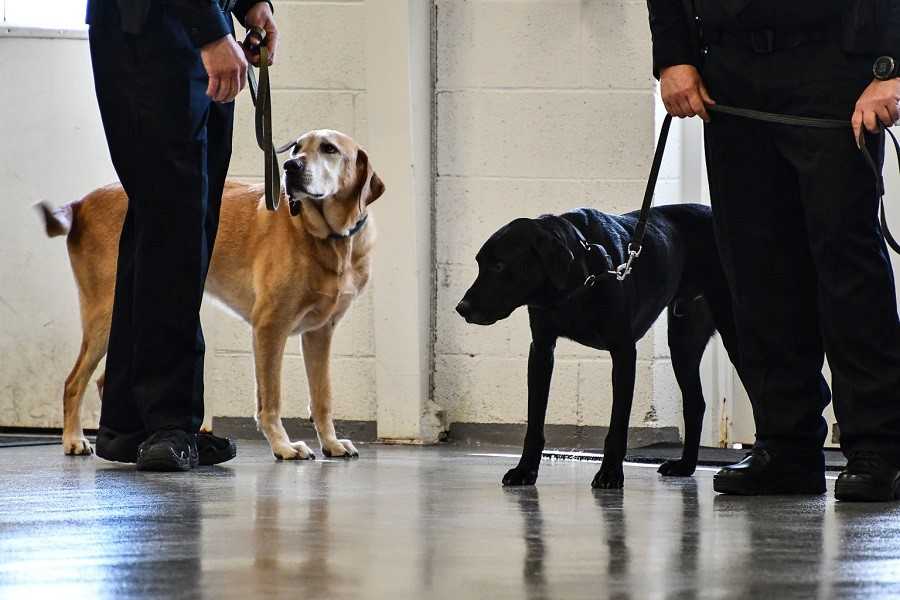
Osmond and Gears with their handlers, just before the new graduates were brought out.
At the end of the ceremony, just before the new graduates receive their official graduation certificates, the veteran dogs and their handlers make their way to the back of the room.
The handlers change leashes from their old partners to their new: a passing of the torch to the next generation of CIA explosive detection K9s.
